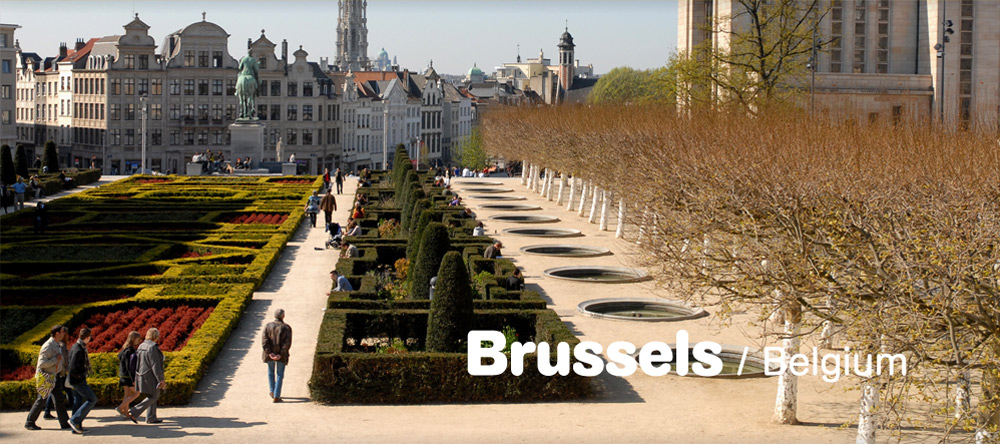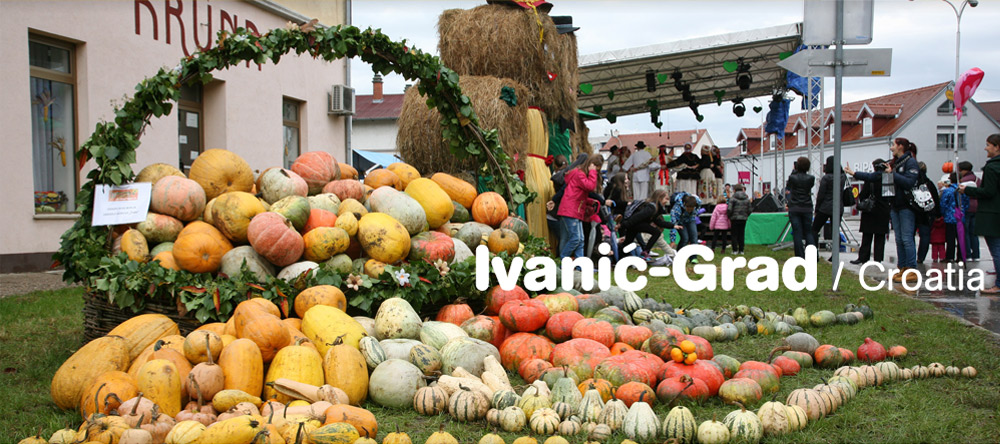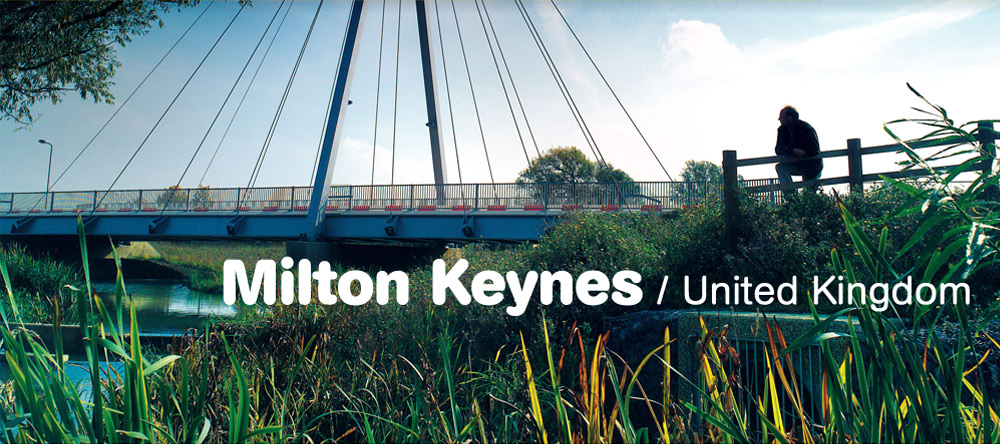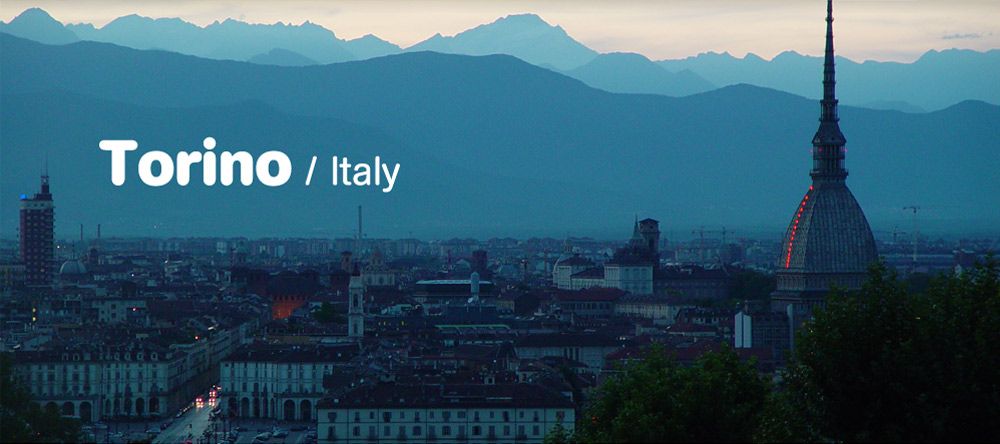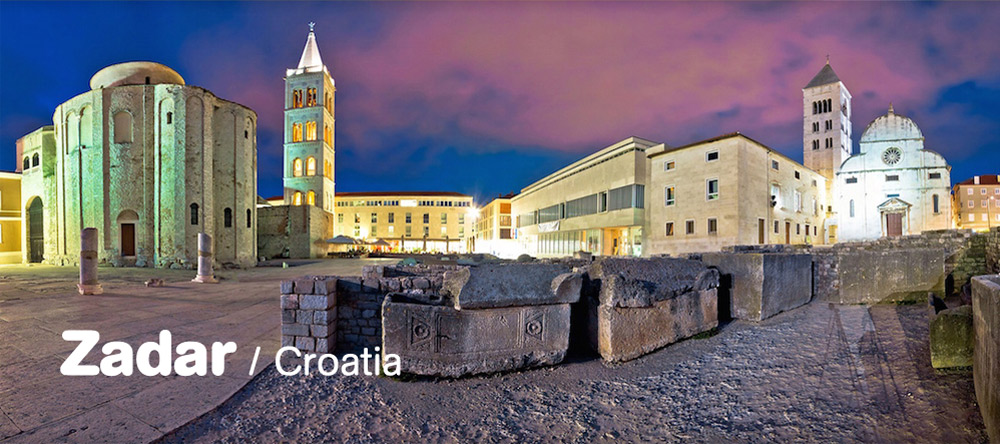EUKI Living Streets
How to experiment new forms of city life
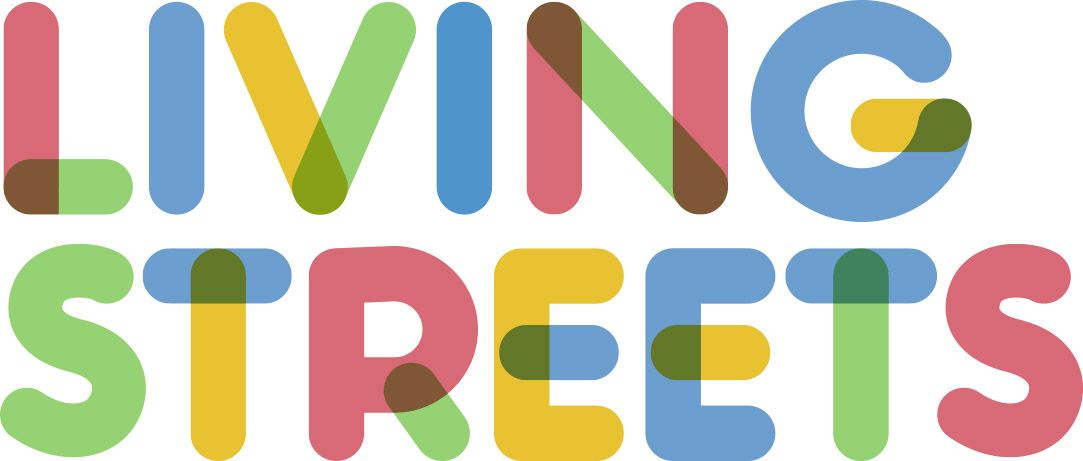
Brussels, Belgium
How are Living Streets organised in Brussels?
Each Living Street requires a preparation period of about three months and thereafter is publicly implemented during one to two months. Living Streets can be organised at any time of the year. An application needs to be submitted by the initiators and the city of Brussels and the Police department need to give the green light for it. A project can be allocated a budget between 1,000 and 5,000 euros.
Brussels Participation is the service of the City of Brussels that supports project leaders launch a Living Street. There is close collaboration with various municipal departments : Participation, Green Spaces and Environment.
The main requirements to organise a Living Street :
- Any inhabitant of the City of Brussels can launch a Living Street where s/he resides.
- The initiator can be an individual, an association, a neighborhood committee or residents’ collective.
- The initiator needs to mobilise at least three inhabitants of the street and create a leading group.
You live in your street, you know it better than anyone else. To know how you want to live in your street, we need your help. The existing situation can always improve and we think that you can play a key role here.
Els Ampe, Deputy Mayor in charge of public works, mobility and vehicle fleet, City of Brussels
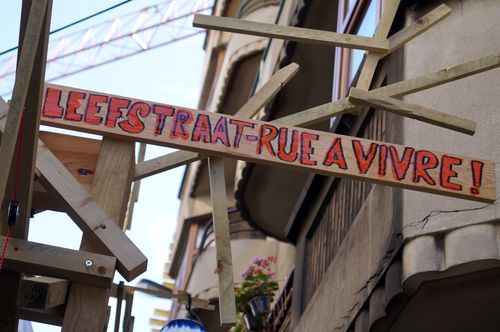
The creation and implementation phases of a Living Street:
- Define the project : choose the location (one or several streets, a market, a public square). At this moment, the steering groups meet Brussels Participation and other municipal services to get feedback on their first ideas and actions they want to implement. To smoothen this step, the municipality prepared a Vade Mecum, a manual helping project leaders to frame their project, working method and budget.
- Field work done by inhabitants : they engage with the other inhabitants via surveys and meetings to choose the actions and to create the steering group, composed of a minimum of three residents.
- Submit the application : there is a form that the steering group needs to fill in and submit to Brussels Participation that details the needs of the street, the vision for their street as well as precise actions and timeframe with a budget. They submit their request for authorisations to be able to close the streets to cars and to organise events in the public space. Via this ’Declaration claim’ form, project leaders agree to respect the Vade Mecum.
- The City of Brussels can advance 80% of the amount requested to the project leader. The remaining 20% will be paid after the presentation of the final report and all financial evidence and after approval by the Council.
- Launch of public activities during the agreed period.
- Submit a final report and all financial evidence.
The municipality of Brussels communicates and promotes the Living Streets via information sessions to citizens in order to raise awareness and encourage the organisation of Living Streets. The initiative has been implemented in 8 streets so far.
In Brussels, the Living Streets tackled many aspects such as prostitution, need for positive animation of public spaces and ownership by their inhabitants, need for green spaces, need for silence in an area impacted by public works during several years, reflecting on the need for a residential zone for meeting and sharing among inhabitants.
What are the lessons learned?
- Everyone wants to join the party, but no one wants to organise it ! It is difficult to move from interest in a project to concrete action as many people are enthusiastic but not necessarily ready to take action to implement and steer the project.
- Involving the press and media too early in the process puts pressure on people
- There was no vandalism during the project, all equipment was respected by the neighbours and other users. However, after the project ended, some equipment was taken over by homeless people.
- A Living Street takes long to organise, it is multifaceted and not immediately visible, making it complex to handle.
- Strong social ties were developed among the neighbours and the resistance of some inhabitants has been overcome by allowing them to concretely visualise the city of the future.
- Residents’ ownership of their street increased via DIY equipment that helped embellish the public space, make it more pleasant and adapted to citizens’ needs and expectations.
For the future of the initiative in Brussels, it was concluded that a Living Streets needs to be extended over longer periods of time in order to meet the expectations of the residents and put them in practice. It is also important to organise several Living Streets in the same spot, to experiment and possibly implement certain solutions on a permanent basis.
Contact:
Ann Van de Vyvere, Coordinator, City of Brussels
Further information:
For more information click here : FR and NL
In Brussels, there are numerous programmes and actions dedicated to residents (see the Public Policy Programme 2012-2018).


Ivanic-Grad, Croatia
Context
The city of Ivanić-Grad is well developed thanks to gas and oil resources, but this has a negative impact on the local environment. The city also faces two important demographic issues: aging population and emigration. Due to the prolonged economic crisis, there are currently empty commercial spaces in the city centre, as well as abandoned land suitable for agriculture. This land belongs to the municipality, to the ministry of agriculture and to private owners who moved out of Ivanić-Grad.
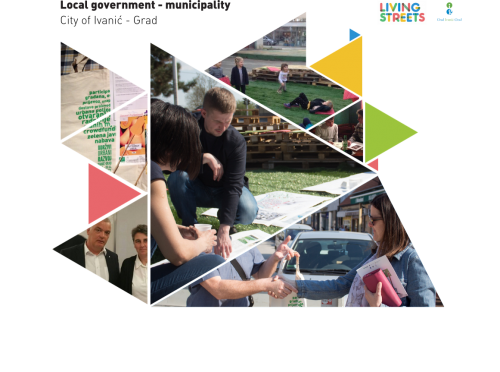
Local food production and consumption, circular economy and changing of mind-sets
In order to address the issue of local food production, in the first edition of Living Streets the municipality organised a pumpkin production contest to attract citizens to the Living Streets initiative and link with an existing popular event: the pumpkin fest.
To all the citizens who filled in the application form, the Mayor of Ivanić-Grad distributed 100 urban gardening sets, including pumpkin seeds, tools for gardening, labels for seeds and instructions. In this framework, the municipal owned land was temporarily offered to citizens who live in multi-apartment buildings and do not own gardens to use it for urban gardening. Their results encouraged them to continue in the coming years, creating a demand for more land for the future Living Streets editions.
Therefore, the municipality is relaying with the national ministry of agriculture to use the plots of currently abandoned land. The municipality is also discussing with citizens who do not use their land in order to make it available for urban gardening. Local family farms expressed interest to buy the locally produced vegetables and fruits. Citizens and local businesses were therefore connected by the municipality to collaborate in the future.
As a Deputy Mayor, I have been following the Living Streets Project since the very beginning because I felt it could be very beneficial to our citizens.
Željko Posilović, Deputy Mayor, City of Ivanić-Grad
During the project I was actively involved in urban gardening. Citizens motivated by my own example of planting pumpkins, started planting them as well. At the end of a successful gardening season, we organized a seed exchange and prepared ourselves for the next season.
I think citizens will continue to partake in this interesting project even after its official ending and encourage each other in planting pumpkins which will contribute to strengthening the traditional city manifestation.
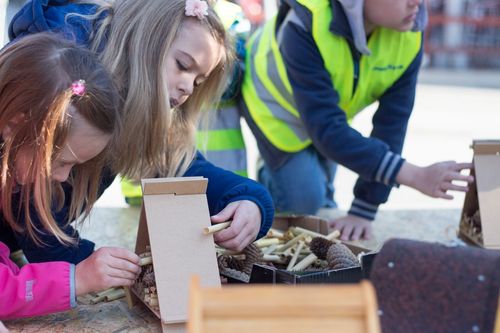
An urban gardening workshop was set up, including distribution of specific toolkits for citizens (pumpkin seeds, tools for gardening, labels for flower beds and instructions). In October the citizens will present their results via a competition (for example: the best pumpkin cake).
Also 4 schools and 4 kindergardens participated via an urban agriculture process focusing on aromatic herbs. Several highshools and NGOs were also involved, namely the Red Cross working with citizens with disabilities.
Furthermore, Living Streets offered the opportunity to exchange experience with Macedonian experts on agriculture production leading to an international trading contract signed between businesses from Ivanić-Grad and experts from Macedonia. In this framework, Macedonian expertise will be transferred to Ivanić and in turn, Ivanić will export innovative products developed within the Living Streets such as urban gardening sets, pumpkin seeds, local eco-toys and eco-devices prepared by local designers and companies. From a social perspective, the project is expected to link up many citizens in Ivanić who are from Macedonia and it is likely that they will reconnect with their families from Macedonia.
In the framework of Living Streets, the municipality encouraged small businesses to cooperate and to communicate on common goals they are reaching for and not to see themselves as competitors. Thus, the NGO Brenta was created to regroup wine producers in order to help them cooperate better. Many produce Škrlet wine, leading to the organisation of a new local event: the festival of the Škrlet wine. They are also now responding together to large market demands for local wine, to which they cannot respond individually. The municipality acted here as a facilitator encouraging networking within its territory by connecting people and businesses.
Ivanić-Grad also organised a local workshop on crowdfunding to link up students and existing and future local producers with two goals: future orientation of the students from the middle school and set up local businesses. As a result, a local cookie factory will be opened, the local bakery developed new products and urban furniture for Living Streets on the main square. Also gardening toolkits and insect hotels were produced thanks to Living Streets connecting Design students who designed the elements, skilled pensioners who pre-crafted the elements according to the drawings and kindergarten children who assembled them. All this got together at the main city square during the green living-room events in Ivanić. So, after the crowdfunding crash-course, the students are considering a start-up in urban design now.
All that it took to make this a true social innovation is the local radio station sharing the right news, passionate handy pensioners, creative and proactive design students and open-minded municipal staff…gathered together via Living Streets in Ivanić.
Local consumption and awareness raising
During the Christmas period, the municipality encouraged the citizens to buy local presents (food, drinks, toys). It turned out that many citizens did not know where to buy these products locally, nor did they know who the local producers were and whether they had a shop. To solve this issue, in the main square an exhibition office was built temporarily and local producers could sell their products there prior to the Christmas period. This proved to be very successful. Thanks to Living Streets, the mind-sets of the citizens are changing regarding the importance of local production and on their consumption habits.
A local pedestrian city centre
In the past, the municipality envisaged to close the city centre to cars, but this was perceived as an unpopular measure at the time.
During the Living Streets, this car free city centre was experienced twice for two weeks during different periods in 2017. At first local businesses and shop owners were worried that their sales would decrease. However, during the urban workshop they understood that even if the square is closed to cars they would still be able to deliver goods. Besides, when they realised that citizens are asking for the square to be pedestrian, they understood that this might be an opportunity for them. The municipality promised to do some communication activities to promote their businesses. Positive results from other European cities were shown to prove that car-free city centres do not come only with problems, but also with solutions.
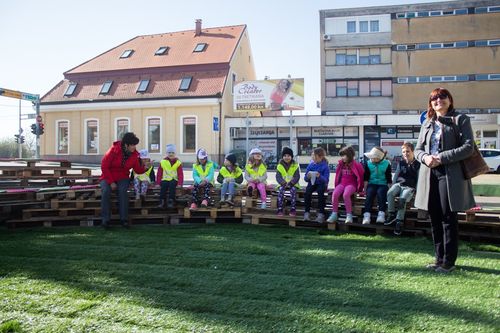
After experimenting and evaluating, the following conclusions were drawn:
- Young citizens and the families with kids see the main square as a safe and thrilling place with green spaces, playgrounds, cafés.
- On the other hand, other citizens (especially middle aged males) voted against closing the main square to cars (they usually can park their individual car in front of the shops).
- It is felt that activities organised within the Living Streets were still not sufficient to change the mind-sets completely and help citizens see that it is much healthier to bike and to walk.
- To make a pedestrian square, budget is required for infrastructure and this is not included in the municipal budget for the next two years. However, experts within the project suggested some soft activities and minor works that do not require a huge budget.
In the near future, the municipality of Ivanić will need to change its urban plans especially related to the historic city centre. It is planned to organise another urban workshop and citizens will be invited again to express their opinions, needs and suggestions.
Only political commitment and a decision from the mayor to close the square for a longer period, for instance six month, can have a bigger effect and allow city officials and citizens to better assess the acceptance and impact of a pedestrian main square in Ivanić.
Contact:
Vlatka Berlan Vlahek, Municipality of Ivanic-Grad
Further information:
www.facebook.com/livingstreetivg/
La Rochelle, France
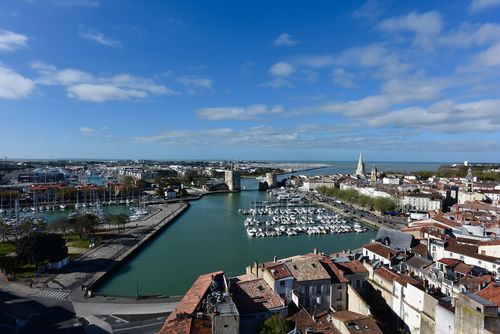
Increase home-to-school and school-to-home travel by foot and by bike: The Children’s Street
The Pierre Loti School is situated in a social mixed area within a small district. An attractive park is situated in front of the school but the Pierre Loti Avenue, supporting 8,000 vehicles daily, disconnects this green area from the school. The parents are afraid to let the children go by bike or by foot to school and think that cars are the safestoption to take the children to school. Many of the school children do not even know how to ride a bike. For these reasons, the Mobility Department of the municipality contacted the school to see if together they could transform this busy road into a car-free street for a day. This provided the opportunity to the children to play in the street and in the park and have fun while learning how to ride a bike. The street in front of the school was closed for one day in June 2016 and May 2017.
The activities organised included: home to school escort by bicycle (organised by the bicycle Police Brigade/Bicycle School) and by foot (organised by the parents), a bike and games lending library, a bicycle training area, some workshops and information on bicycle repairs, biking safety, using public transport, free trial of different cargo bikes with bike stores.
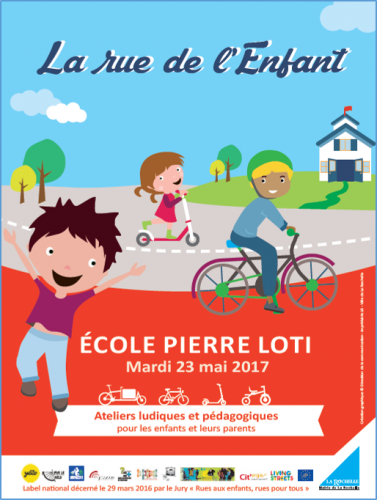
This initiative has enabled the creation of a playground in the park next to the school and bicycle parking places. It also favoured inter-generational exchange between the school and the nearby retirement home. Parents launched a petition to have shared urban gardens in the park. It was decided that 60,000 euros will be spent by the municipality to set the garden up which will be open to all residents in the neighbourhood, including the retirement home. Besides, bike stores have increased their income and are selling more bikes, including foldable bikes and cargo bikes. Elected representatives, teachers and parents are now reflecting on how to include bike learning in the school programme.
The Children’s Street initiative is sustained by several activities. Following the 2 one-day events organised by the municipality, the school and the parents have organised on their own a 3rd event in April 2018, including a bike market and a party in the street, with the participation of associations. The municipality initiated the process and now parents, children and school teachers are responsible to organise such events in the future, with the municipality offering support, but not acting as a driving force anymore. In addition, other schools are interested by this initiative and a new Children’ Street with another school will be organised in a different neighbourhood.
Develop the attractiveness of commercial areas in the city centre
The first experiment took place in the old market place from July to August 2016. This place is today used as a big round-about for cars, reducing the space available for pedestrians. The shopkeepers would like to reduce the car’s presence but at the same time authorise freight access for the market in the morning. A modular access was therefore needed. A solution was found together to regulate the access, using colourful signs to mark the limits of the pedestrian zone during the event.

From July to August 2017, the second experiment was organised in the Saint-Nicolas district, a small shopping area, a little hidden away just behind the old harbour. The aim was to make this neighbourhood visible from far away and attract more people to this area. All the shops are small local shops and shopkeepers are struggling to attract more clients to the city centre, taking into account the competition of the huge commercial areas located outside of the city centre. Posters showcasing shop owners have been produced by the municipality, using the ENGAGE poster tool (www.citiesengage.eu). Shop owners could promote cycling on these posters that were displayed in their shops. An exhibition of ENGAGE posters has also been organised by the municipality, including posters with students, teachers, civil servants putting forward their different arguments for cycling.
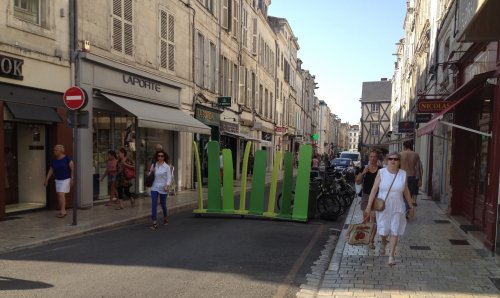
The most significant result of these experiments is the change of mind set of shopkeepers who no longer claim “no car, no business”. More people are now shopping by bike as citizens realised that the cargo bike is faster than the car. This shows that it is important for people to have a voluntary behaviour change, but for that it is crucial that they try and experiment beforehand, so that they realise the advantages that a different lifestyle might bring. Shopkeepers are using bikes to buy their products and to dispose of their waste. Bike stores and shop owners have increased their income during this test phase, some of them by up to 25%. The shop owners’ association, gathering almost 100 members, are now reflecting on how to encourage shopping by biking and walking to make this lifestyle attractive to their potential customers and thus differentiate themselves from the big commercial centres on the outskirts of the city where customers need a car to shop there. The project has also brought more sociability, for example shop owners now put chairs outside of their shops, in order to invite passers-by to sit and appreciate the excellent quality of life in their city.
Living Streets: a modular experience for the city of La Rochelle
Living in an urban environment conceived for car use, makes it difficult for people to imagine and have another vision for the future of the public space in their city. The municipality of La Rochelle implemented
Living Streets as a motivating and modular experience allowing citizens to experiment different aspects of what life without a car means and see all the benefits that this might bring to them. However, with this experience, the municipality of La Rochelle does not aim for example to replicate the same children’s street in all schools, but a new concept based on the needs of each district. Each street is different and the municipality aims to keep the co-construction process that took place in the first children’s street. The
Living Streets enabled seeds to be planted for the future, provided time and space for first-hand experience and let things happen.
Contact:
Birgitta Morin, Sustainable mobility officer, City of La Rochelle

Header text
Milton Keynes, United Kingdom
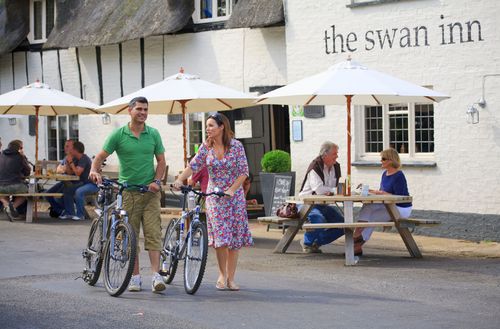
The challenge of implementing Living Streets in a new town
In MK the individual car is the main mode of transport, facilitated by a grid system similar to Los Angeles. Milton Keynes has few traffic lights and many roundabouts which makes driving around the city easy and the promotion of sustainable mobility more difficult.
However, there are 250 km of cycle and walking routes in MK, called “redways” that are completely independent from car traffic. MK has also many green spaces and sidewalks for pedestrians.
So, the challenge Living Streets faced here is to solve something that is not yet a problem as currently there is no traffic congestion, people are able to drive around the city easily and plenty of parking space is available. Nevertheless, by 2025 it is estimated that there will be a travel demand increase of 60% while practical capacity improvements will only address a 25% increase.
Community engagement establishes understanding between neighbours and promotes inclusivity. The Living Streets project is a great idea that fulfils this role and contributes to the positive vision we have for Milton Keynes in 2050 and beyond.
Councillor Peter Marland, Leader of Milton Keynes Council
Reaching out to local councillors, civil servants, stakeholders and citizens
Living streets encouraged departments in the Council working together that do not habitually collaborate such as the energy and culture departments.
For Living Streets, MK residents were approached in different neighbourhoods throughout the city. Enthusiasm for the project was shown on several occasions however each neighbourhood eventually declined this opportunity for several different reasons: lack of time, opposition of a few inhabitants who didn’t feel comfortable with the idea of Living Streets or the budget offered for implementing Living Streets was not appealing enough, particularly compared to the budget residents usually receive for initiatives such as creating a community orchard. In this car-centric city there is a real anxiety for most citizens about walking and riding a bicycle and residents are reluctant to make something unpopular happen in their neighbourhood. Having to think differently and give up parking their individual cars in front of their houses was difficult for most streets. Citizens seem to be happy with the quality of life they have in this 50-year-old city where they do not face traffic jams. Most citizens have no problems with finding parking spaces at home, leisure activities and at their place of work while still being able to enjoy green areas on their doorstep.
Looking forward to the project and no cars. I’d welcome more buses, especially running along Watling Street all the way to Bletchley.
A Milton Keynes citizen
I wish it would create parking spaces though, rather than lose them!
A Milton Keynes citizen
The conclusion is that people need to be encouraged to be involved in their street projects by starting small and taking baby steps. Focusing on their fears and worries, such as time spent commuting in their cars, would be a good starting point for Living Streets in the future. Gaining trust and support is a very slow process and initially the support offered by the MK Council was perceived as top down but it did improve over time.
What a lovely idea. I’ve often hoped that the top end of the High Street would be pedestrianised. This would make a huge difference to the Town.
A Milton Keynes citizen
The MK coordinator met with several not for profit organisations to discuss working together to make Living Streets happen in their area. This brought together like minded people and was a good way to reach active citizens in the MK communities. Meetings were arranged with local clubs, associations, residents’ associations and charities and mutual goals were realised. One collaboration resulted in meeting families at two events organised with the Milton Keynes Play Association and MK Council will continue to work with this organisation in the future.
We are acting as catalysts with local communities, encouraging people to have a say in how their street and quality of life could be improved. This is important because there is a general view that the council makes decisions from the top down.
Christine Ballard, Neil Sainsbury, Shane Downer, civil servants at MK Council
The Living Streets project provided a great way to meet citizens and learn more about what is important to their communities from those who live there. The work invested in this project has built relationships with citizens and broken down barriers in communication. This ground work will continue to reap benefits in future community projects.
Neil Allen, Head of Regulatory Services, Milton Keynes Council
Living Streets is planting a seed for the future
It is well known that personal transport is difficult to replace in the UK and particularly in Milton Keynes because it was designed for cars. However, some communities were willing to accept this restriction. Thames Valley police are interested in collaborating in Living Streets mainly because neighbours talking to each other means problems can be discussed. Furthermore, Town and Parish Councils are also familiar with Living Streets and are willing to proceed to some traffic restriction.
It was amazing to witness first-hand how the Living Streets Programme proved that streets can play such a fundamental role as an extension to private gardens and provide a place for residents to socially interact.
Neil Sainsbury, Head of Urban Design and Landscape Architecture
When we visited Ghent, it was evident that streets can be the glue that knits residents together.
Living Streets have also had a positive influence on future planning strategies in a growing city where new neighbourhoods will be developed based on a more people-centric approach. This is the fruit of strategic municipal departments being involved in Living Streets and of the widespread understanding within MK Council of this initiative.
So, in Milton Keynes, the Living Streets initiative has planted seeds and supporters of the idea are waiting for conditions to become more fertile so results become real and visible.
Contact:
Christine Ballard, Project Manager, Sustainability Team, Milton Keynes Council
Rotterdam, The Netherlands
A cross-sector process to create Dream Streets
The Dream Streets take place within the framework of the “Citylab010 fund for local innovation” (2015-2018), containing an annual amount of three and a half million euros in total. All municipal departments are involved in the programme. With CityLab010, the Municipality of Rotterdam aims to generate and support initiatives that contribute to the further development and improvement of the main municipal policy challenges, such as: sustainability, economics, sports and culture. Via CityLab010 a grant fund is available, for proposals of local initiatives that can be submitted.
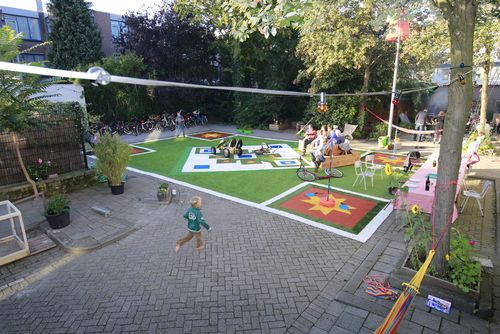
For each of the Living Streets implemented up till now in Rotterdam, a dedicated inter departmental team of 5-7 civil servants meet regularly before and during implementation of the specific Living Street. They advise the inhabitants on their plans and assist during implementation when needed. The Living Streets are managed by the Urban Planning department with a large involvement of the Traffic department and Maintenance department.
The process of Dream Streets in Rotterdam is as follows:
- A new dream street initiative approaches the dream coach of the city of Rotterdam. He assists them in defining their plan and introduces them to the interdepartmental team (“Kendoe team”) which advises on the plan and budget. They also check that the planned activities comply with the regulations. This team meets once or twice and they help to further improve the project and give support and suggestions. Usually this process takes a couple of months. After this, the Living Street submits their proposal for funding by the Citylab010 programme.
- The final proposal is assessed by the Living Street project manager. The interdepartmental team formulates the conditions for funding and the Living Street receives a subsidy contract. During implementation, civil servants assist and advise if needed. This means that in some Living Streets, there is a high level of involvement of the city administration, while in other Living Streets there is much less. In all cases, there are many formal and informal moments of contact between the Living Streets and the civil servants as often, civil servants attend the local Living Street events.
- After implementation, each Living Street submits a financial and narrative report on the results. Thereafter, the civil servants and the inhabitants discuss together which of the temporary measures could be continued or become permanent. Evaluation is also done by the Living Street initiators, sometimes using monitoring equipment bought by the municipality, but also based on a qualitative analysis.

The Dream Streets activities and their impact in the streets and the municipality
13 Dream Streets were organised between 2015 and 2017, covering topics such as improving traffic safety, enhancing social cohesion, building permanent places to play and meet, greening communal gardens. Most Living Streets have a time span of one year in which they organise several activities, mainly in spring and summer when the weather is nice. The most represented social category is highly educated people, however some Living Streets are also taking place in socially and economically mixed neighbourhoods, where a professional organisation is needed to develop the plan and coordinate the project together with the citizens.
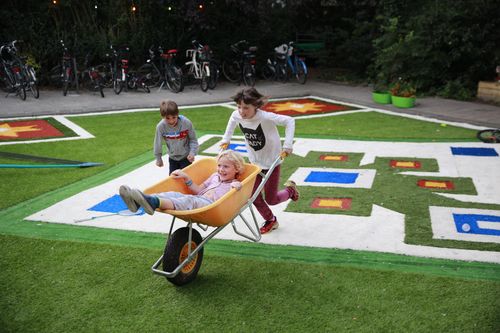
The Dream Streets have diverse impacts. First, they bring more social cohesion to the streets as well as an increased sense of ownership of the public space by residents. Besides, these experiments, before investing in permanent measures, enable the municipality to have more insights on what works well or not in the streets to enhance meeting and playing. Some measures then become permanent, such as reduced space for car parking, benches, small playgrounds and meetings places. These initiatives also have an impact on rethinking the role of the municipality: How do we cooperate with citizens? What do they expect from us? Are we capable to explain the municipal regulations for public space well enough and how do we manage to bend the rules without breaking them?

Challenges ahead
The successful experience in Rotterdam has raised a number of key questions:
- How to deal with temporary versus permanent measures?
Most permanent measures concern the installation of bike parks, benches and playgrounds. As this is public space, the city administration should implement these measures and citizens are not allowed to do this themselves. However, permanent measures need a budget, which is not always available. Some solutions were found by the residents, for instance via crowdfunding. - How to deal with initiatives from professional organisations?Professionals also approach the municipality with their ideas (like architects, urban planners) and find citizens to join them. How to ensure that the citizens feel and take ownership of the project? The municipality then considers that at least 10 residents from the street should support the proposal so that it can be accepted.
- High diversity: not everything is a Dream Street!
In Rotterdam, there is a high diversity of initiatives that qualify as Living Streets. This is also a risk, as not every local initiative is a Living Street. What to do with this diversity of proposals? - Do we “spoil” our Dream Streets?
A Dream Street can receive a subsidy of up to 40,000 euros. The positive effect is that real changes can be made, the negative effect is that this may hinder creativity. - To what extent do we coach the initiators in engaging their neighbours and getting their support?
Some initiators, especially in mixed neighbourhoods, find it difficult to approach all neighbours in their street and to involve them in the project. What kind of support should the municipal administration give them? - When is the support for the plan sufficient to continue and if not, how to deal with that?
Most Living Streets are initiated by highly educated people. In socially and economically weaker neighbourhoods, professionals write and submit the proposals and involve the citizens in the implementation.
Contact:
Esther Sprangers, Project manager, City of Rotterdam
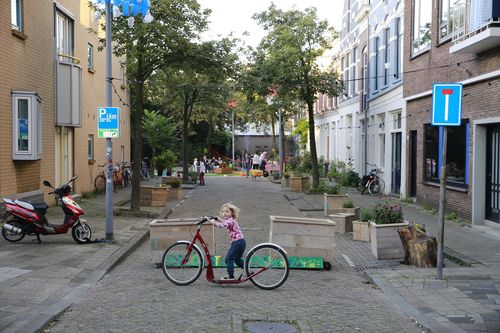
Turin, Italy
A living lab in the Campidoglio district
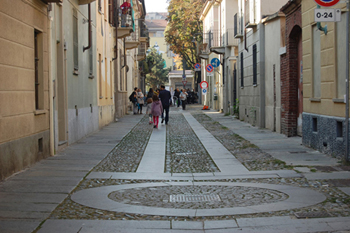
Campidoglio (5,000 inhabitants) is mainly a residential district and it is also home to many local artists and craftsmen, but is not a touristic neighbourhood. Campidoglio is characterised by narrow streets, full of cars. Currently there is only one pedestrian street, but this is not really respected as people still continue to park and drive there. In this district residents are willing to take back the streets and organise something else in the public space. The municipality supported this process by proposing Laboratorio Campidoglio to facilitate meetings with the citizens, allowing contact among themselves, but letting them be the main contributors to the Living Streets activities.
To prepare the events, the municipality contacted all associations in the neighbourhood as well as the craftsmen. In June 2017 a world café workshop was organised involving about 30 participants to develop ideas for activities: What can we organise to make the area more liveable? All the ideas were discussed in terms of their feasibility and based on this a follow-up workshop was organised in July to define the agenda of the Living Streets event. Participants highlighted the need to make the borough more visible to its inhabitants but also from the outside so that is becomes more inclusive.
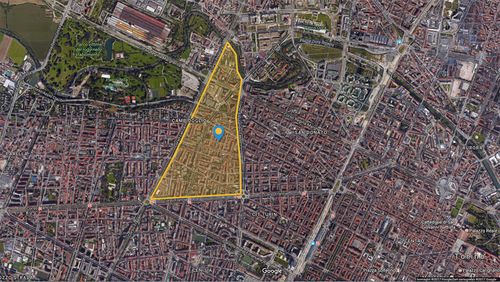
Citizens showed great interest and participation in the life of the borough: they are more aware of the nature and future of the area, which is not merely the pedestrianization, but also taking back the public spaces and making the neighbourhood more valued and lively. With the Living Streets, the citizens have realized the potential of the district where they live!
Carlo Zanella, craftsman
We need to encourage people to go to this borough. But how? For instance, by opening shops on the street that arouse the curiosity of visitors.
In September and October 2017, two two-day Living Street events were co-organised with the active participation of the citizens, shops, schools and other associations within the neighbourhood. These events attracted numerous people outside of the area who came there for the first time.
A wide range of activities took place:
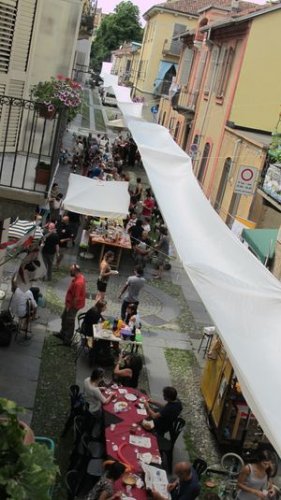
- Painting workshop: One of the local artists in the neighbourhood proposed a painting workshop with children on the topic “what neighbourhood would you like in the future?”.
- Consultation of citizens who were asked to imagine the neighbourhood with different modes of mobility, what kind of possibilities they see to change this area into a pedestrian zone and also what street furniture they would need to make this area more comfortable. Citizens suggested to have benches, plants, public furniture. Urban furniture was installed with the help of a group of citizens already involved in urban agriculture.
- Role play with the primary school: Role play involves imitating the character and behaviour of someone who is different from yourself. Children were playing roles such as a disabled person, a mum with a pushchair and little children, so that they could see with the eyes of the role they were playing which were the problems of the area. After the tour of the neighbourhood they could come back with difficulties they faced and they were aware of, allowing them to reimagine the Campidoglio district without all these issues. Some children were playing the policemen, putting papers with messages on cars that were not appropriately parked. These were not real fines, so were positively perceived. The message was simply saying: “And me, where can I go?”.
- Art exhibition: Local artists from the neighbourhood organised an art exhibition, including paintings with sights from the Campidoglio district. This allowed some artists to be promoted and be more well-known while making people discover specific spots in the neighbourhood illustrated in the paintings.
- Debate on future activities: A debate was organised to think about what should be done after the Living Streets event. Citizens appreciated that Living Streets made connections between them and now they are growing as a group and want to be more autonomous. This ensures that at the end of the project citizens still want to act and continue this process.
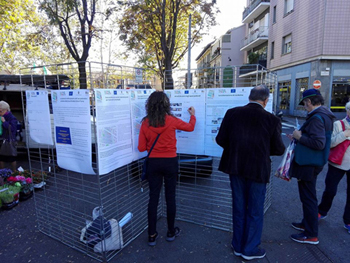
The impact: a collaborative project that brings more social interaction to the district
The Living Streets events confirm that the citizens wish to revitalise the public area in Campidoglio. Traffic and parking were the most debated themes during this experiment.
Thereafter it was officially decided that by the end of 2018, part of the Campidoglio area will be pedestrianised and this is causing a big turmoil in the district. The majority of the inhabitants are satisfied with it, but some are worried about the toll parking or the distance of the car parks from their home. Residents will need time to integrate the transformation in their daily lives, but the first impression is that there is a general acceptance of this decision.
An important part of Campidoglio will be pedestrianised: this result certainly represents a positive outcome because it closes a long path of confrontation and positional conflict and inaugurates a phase of concrete definition of solutions for the future of the district.
Claudio Cerrato, President of the District, City of Torino
Now a stable group of citizens is acting as intermediary with the District and meets regularly in order to discuss the improvement of the area.
Without a doubt, this happens thanks to the “constructive” climate created by Living Streets.
The social cohesion in the neighbourhood has considerably increased and a discreet number of citizens now meet regularly to discuss issues regarding the daily life of the borough. Schools, commercial activities and citizens are aware of the importance to exchange ideas and listen to each other in order to make proposals and implement them together.
New activities have been created following the Living Streets events: the creation of a monthly street market of arts and crafts made in Campidoglio, as well as urban gardening activities with citizens and schools.
Further information:
http://torinolivinglab.it/laboratorio-campidoglio/
Contact:
Michele Fatibene, Policy Officer – Responsible for Innovation, City of Turin
Rossana Guglielmetti, European Policies manager, City of Turin
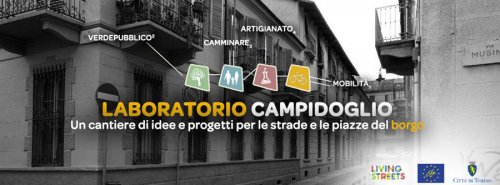
Zadar, Croatia
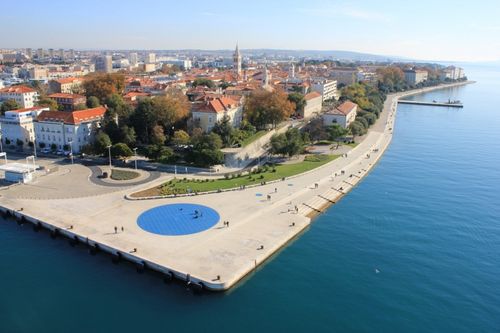
Bringing neglected areas back to life: making the Voštarnica of tomorrow visible to all!
The area was neglected and most residents avoided it, being used only for parking cars on three big parking slots which are crowded the whole year. This is precisely the key aspect that the municipality wished to change by using Living Streets to show another perspective of this area to the citizens, allowing them to see the potential to host other activities rather than merely parking cars.
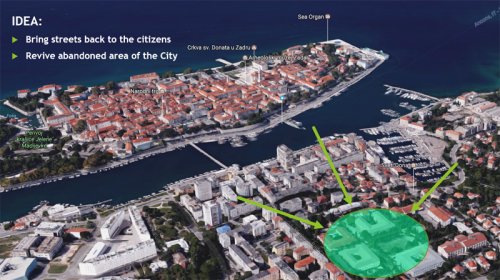
In Zadar, the Living Streets were linked to a local festival called Kvart Art (neighbourhood art festival) and it was decided to use this opportunity to create more than 80 activities during the event taking place in this derelict area. Even during time slots with no activities, people could still come and socialise, recognising this area as a key meeting point. This allowed different social groups and ages, from children to seniors, to gather and mingle.
The Living Streets initiative also received political support from the Mayor who was directly involved and participated in the initiative.
Preparatory activities: changing perspectives and future of the area
Prior to the event, important preparatory activities took place. The area was cleaned, the parking lots were rearranged, the public space was prepared, flowers and trees were planted. Local residents were involved in rearranging this public space, in the gardening and watering of the plants.
Also some exhibitions, master classes and an architecture workshop were organised. In this workshop young architects were thinking on how to refurbish this area and how to improve the space. The ideas were based on low budget solutions that can be implemented in short time. The citizens could express their views on the future of this area via a survey and via a big common board where all citizens could write their ideas.
Get inspired by Zadar’s activities!
The Living Streets was officially opened via a metaphoric performance when citizens could break a cardboard wall, symbolically showing the barriers to a liveable Voštarnica neighbourhood. Different tools were provided to citizens (chalk, spray cans, etc.) that they could use to mark their visions for the future of the area on a big white screen. An idea box was also provided, gathering suggestions that were used at a later stage by a team of architects presenting future low-budget solutions for the area, based on the needs and dreams of the residents.
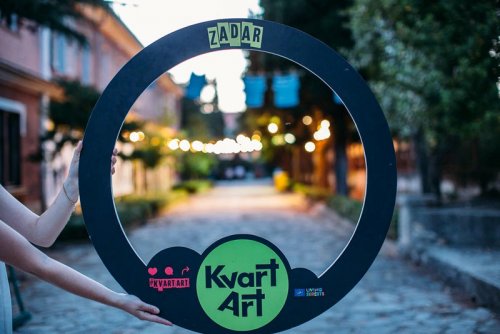
To allow residents to picture their area car-free and see all the potential of it in terms of socialising and a better quality of life, during the Living Streets a set of activities was proposed every day.
Below is a list of activities for inspiration:
- Change of perspective: members of the local firefighters came with their vehicle every weekend and they used the crane to lift people up in the air so that they can have a different view on the area from high above and realise the impact of transforming it from a space dedicated to cars (parking lots) into a space dedicated to people.
- Book exchange picnic: local craftsmen made wooden houses to store the books and placed them outside of the public library, on one of the parking lots which was transformed for this period in an enjoyable place with flowers and trees. Residents could exchange their preferred books and read them outside. This construction is now there permanently and residents are still using it.
- Electric bike presentation: this involved different local bike shops promoting electric bikes and residents were able to try them free of charge on the day.
- Family activities: music concerts for children, archery workshops, and children chess championships.
- Souvenir development creative workshop: this involved seniors, with the support of the Eco Zadar association.
- An open space cinema, followed by a movie quiz.
- Physical theatre workshop: focusing on the body and physical acting in theatre.
- Outdoor theatrical performances, puppet shows.
- Development of lighting installations: residents could create their own lighting installation.
- Sunrise breakfast: this included activities supporting healthy lifestyles (education, training, running, healthy food for breakfast).
- Music concerts were organised with the performance of the well-known guitar player, Miroslav Tadić (traditional and alternative playing), involving more than 500 people coming to this abandoned place (skate park). The guitarist invited everyone to hang out in the parking transformed in a living room and this turned into a big after-party that was very successful, allowing residents to socialise.
- Alternative music and journalism workshops with famous journalists.
- Graffiti and art performances: citizens could have an active role in the graffiti workshops and were invited to ask questions and express themselves.
- Sport activities: mountain climbing with local associations, children’s sports Olympics.
- Public viewing of the football game (like the movie night) with a barbecue.
- Parkour workshop.
There was a positive atmosphere during the entire festival and Living Streets revealed that the Voštarnica neighbourhood has a great potential to become a place for social interaction of the residents in the area, but also of all citizens of Zadar.
In 2018, the City of Zadar is continuing with the initiative, but this time in close collaboration with 4 local institutions and associations.
What was the impact?
The experience shows that in the derelict area concerned, the people’s acceptance increased concerning the closing of the parking lots to the cars and transforming them into public space dedicated to the people.
There was also a snow ball effect as the participants in the Kvart Art festival are thinking about the future of their own neighbourhood now, in different parts of the city and on how to turn the parking lots in their own districts into other initiatives than just space for parking cars.
It seems the first Living Streets experiment in Zadar is an eye opener for politicians, the administration and the citizens on the potential of this neighbourhood and the festival will be organised every year while permanently reorganising this area, transitioning from cars to citizens.
Further information
facebook.com/kvartartzadar
Contact:
Stefani Mikulec Perković, Head of the Section for Integrated Territorial Investment, Department of EU funds, City of Zadar
Josip Milić, Head of the Section for Preparation and Implementation of EU Projects, City of Zadar
Corinth, Greece
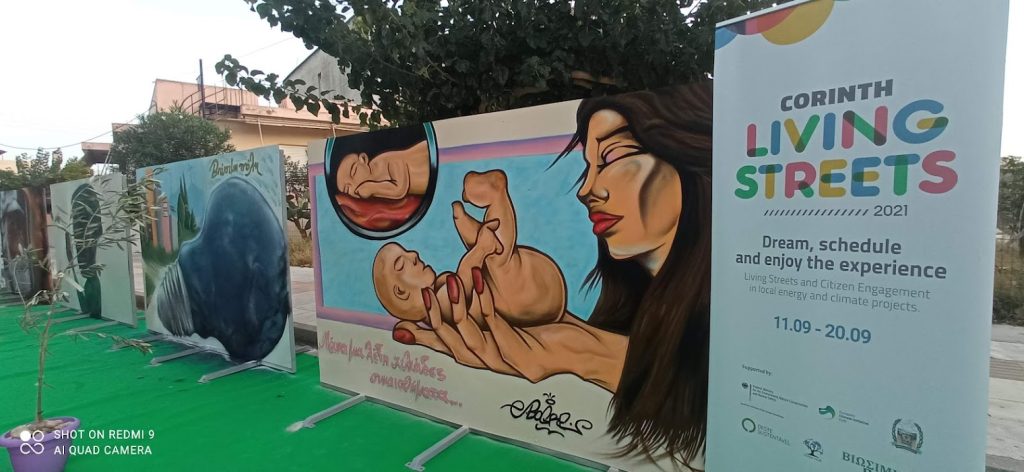
Dream, plan, enjoy!
The streets of Corinth were revived, with the motto “Dream, plan and enjoy the experience”, as the city became a pole of attraction, growth, and development. The Municipality of Corinth, having developed ideas and plans for the transformation of the historical city centre of Corinth, carried out various engaging actions in 3 different locations during 3 different periods:
- From August 1st until 8th, in the centre of Corinth, the held such as street shaping, a chess festival and art events for children.
- From August 21st until 28th, the Living Streets took place at the port of Corinth. They installed a giant cinema screen, and hosted conferences from scientists on climate change, environmental protection, health issues, history, and social issues, among others, and set up a digital planetarium for stargazing activities.
- From September 11th until 19th, the Living Street moved to the beach, with graffiti boards, a bike ride, a 9-km-race, and street shaping activities.
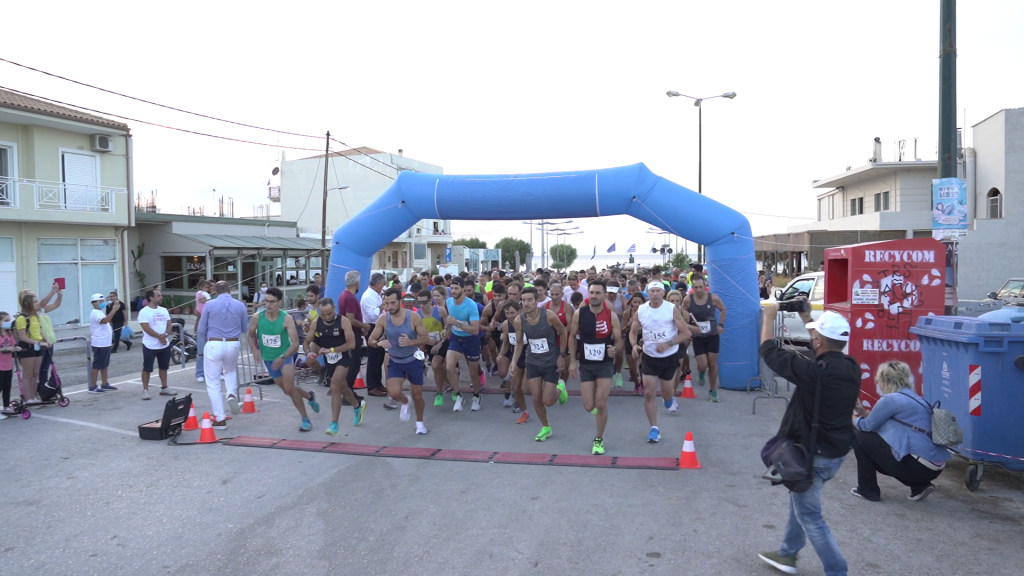
An example of inclusivity
The Municipality of Corinth decided to carry out actions in three different locations in three different time periods. The opted to use three different locations because they wanted the Living Streets actions to reach as many neighbourhoods of the Corinth region as possible. The aim was to maximize the participation of citizens in the project and to mobilize different social and age groups.
From the municipality’s side, Living Streets’ team gathered elected representatives and more specifically the vice-Mayor, the Technical Services Department, the Sanitation & Recycling Department, the Procurement Department, the Centre for Culture, Sports & Environment, as well as the Municipality’s Press Office. During the planning of the project activities, residents and local stakeholders (such as trade association, sports club, the red cross, the police station) were consulted. Their inputs and suggestions revolved around the best way to implement actions focusing on the concepts of sustainability, promotion of alternative forms of transport and enhancement of social links. Particular emphasis was placed on the reinforcement of social interaction with neighbours and making new acquaintances, to contrast the effects of the health crisis in the country.
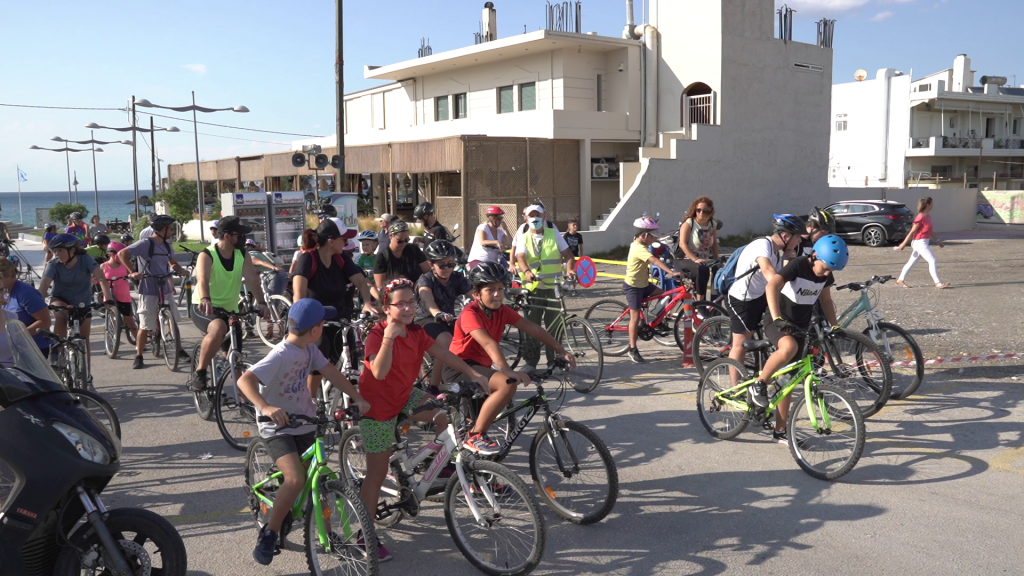
What was the impact?
During the implementation of the actions the citizens of Corinth and the visitors had the opportunity to gain knowledge on the critical issues of our times, such as climate change, environmental protection, social and health issues. They had the opportunity to interact with their fellow citizens and the Municipality by expressing their views on the development of the program. With the prohibition of vehicular traffic on certain streets, air quality and noise pollution levels improved. Detailed data was recorded in cooperation with the National Observatory of Athens and the Municipal Engineering Department. In addition, one of the objectives achieved was to create long-term positive impacts related to the change of mindset in the lifestyle of citizens. The presence of many citizens on the temporary pedestrian street had a beneficial effect on the economy and the social cohesion of the city. The municipality is currently considering to pave the streets that were temporarily closed and/or other streets to become an extension of the existing pedestrian walkway and square.
Further information
See the Corinth Living Streets website: https://corinthlivingstreets.com/
Contact:
Andreas Panousis, Special Advisor to the Mayor of Corinth
Ellinikó-Argyroúpoli, Greece

Playing in the street
The core of the Living Street in Ellinikó-Argyroúpoli was based on the display and promotion of traditional street games. The aim was to introduce young children to the games their parents and grandparents used to play out in the streets of their neighbourhoods. It is worth mentioning that these games have now been almost forgotten, as children find it very difficult to play outside today due to lack of space and time and of course safety issues.
On top of several municipal departments (Planning, Organization and Informatics, Environment and Civil Protection, Ecology and Climate Change, Social Services, Municipal Police, Traffic, Signalling and Public Transportation, Environment, Procurement and Maintenance), local stakeholders (businesses and associations) and residents as well as 3 volunteer bodies – Women’s Movement, Forest Protection Firefighting Team and voluntary association – were deeply involved in the design of the Living Street. The firefighters taught the children how to be responsible as citizens and how to protect the forest, the women’s association «ΚΙΓΕΑ» made bracelets and taught the children knitting techniques. An artist helped the children express themselves through colours and paint the city of their dreams. Some other innovative actions were two video clips created by mixing songs recorded at the Concert Hall by the children of the kindergartens and the children’s choir of the municipality with shots taken during the actions of Living Streets.
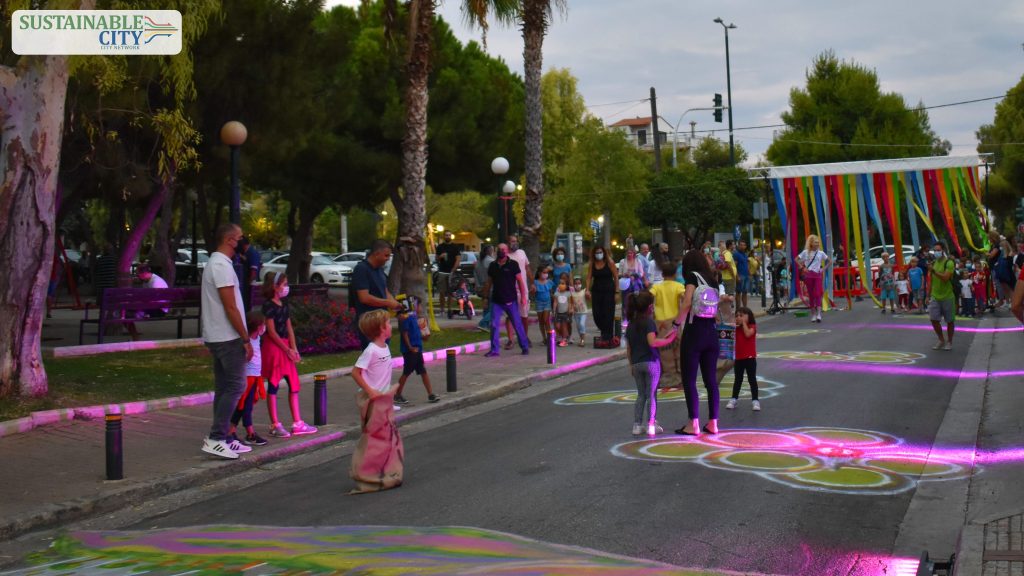
Overcoming negative reactions
The original location for the implementation of the action was a section of Marinou Geroulanou Street, one of the busiest streets in Argyroupoli area. The location was chosen after numerous meetings with the relevant departments of the municipality and with the consent of the mayor. However, during the neighbourhood meetings and after interacting with the public, strong negative reactions were generated by a few business owners: they argued that the temporary sidewalk would create severe problems in the area, especially in terms of parking and vehicle movement, which they feared would result in reduced customer traffic. Although the opposition came from only a few business owners, the intensity was very high, and when the project was brought before the City Council for approval, it was not voted on.
Following the first negative outcome the action was redesigned. Meetings between the involved departments were held once again, members from the volunteer groups were invited and residents and businesses were informed about the new location to finalize the decision and present it to the municipal council. In July 2021 the final proposal was approved by the Municipal Council. The decision was for the project to be implemented in Elliniko area during the period 12-22 September 2021 in a part of Chrysanthou Trapezountos street, the National Resistance Square, and the adjacent side street.
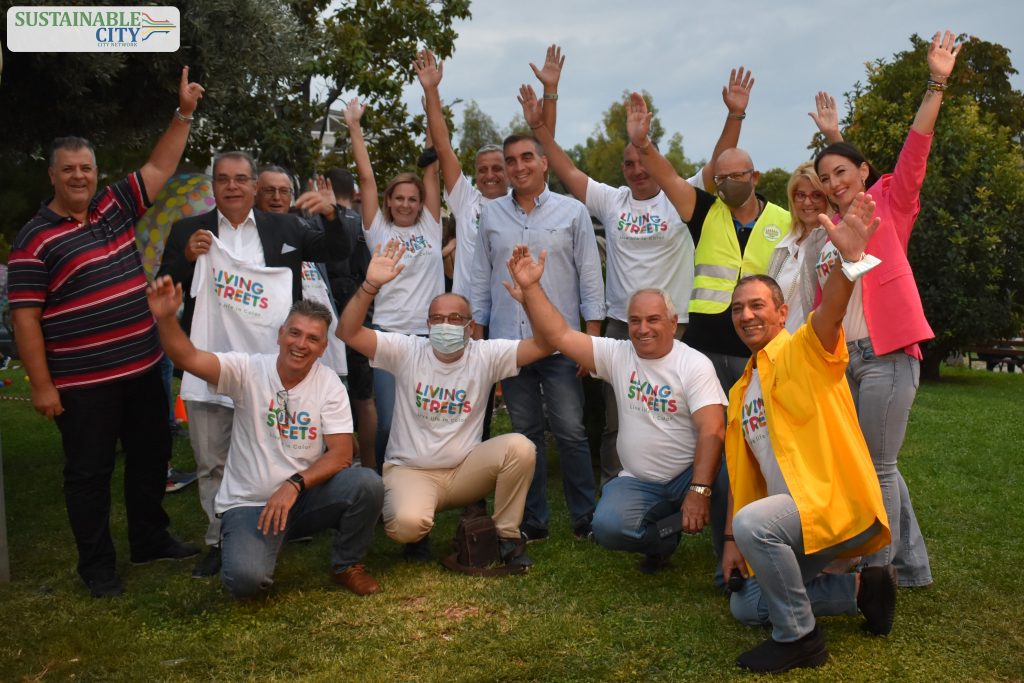
What was the impact?
The difficulty and the beauty of the whole process was the high number of services and competent authorities involved. There were many different opinions it took several meetings, long hours, a lot of effort and a very positive attitude to get everyone on the same page. By offering free activities, the project enabled the citizens to redefine the way they see their neighbourhoods. The involvement of residents and stakeholders in the planning of the actions created a sense of responsibility and a feeling of belonging to a larger group with a shared vision, resulting in a greater commitment to the activities. The businesses stated that their clientele increased and in general there was a positive atmosphere among their customers. The action was tailored to the needs of children, as the pandemic had increased the desire for contact and cooperation. It is worth mentioning the improvement of air quality during the ban on the passage of vehicles and thus the positive impact on the health of residents, which was monitored thanks to a cooperation between the Municipality and the National Observatory of Athens. This project highlighted the need to redefine neighbourhood spaces where young children can play and be entertained safely. Living Streets’ success was also the trigger for the political leadership to integrate equal use and safe access to the city streets in the planning of social actions and the competent agencies might consider it to take further actions in the future. Since the activities were so popular, the Municipality may organize cultural events on a more frequent basis. In addition, emphasis will be placed on setting targets for the improvement of the environmental parameters that were addressed during the project.
The municipality benefited from the selfless contribution from volunteers, improved its aesthetics and has now proved how synergies have the power to transform the dull urban landscape into hubs of culture and mutual benefit. The most important lesson learnt was that the most beautiful things in our lives are in daily, simple actions and play. As Nikos Kazantzakis, a famous Greek author, once said “There are no ideas, there are only people carrying ideas, and the ideas take the height of the person who carries them”. Moreover, the Municipality of Elliniko – Argyroupoli won the Bronze prize in the category “Municipal Responsibility” in the Annual Best City Awards in Greece for their Living Streets!
Further information
See the Elliniko – Argyroupoli Living Streets promotional video
Contact:
Dimitra Varoutaki: varoutaki@elliniko-argyroupoli.gr
Faro, Portugal

Turning a parking lot into a garden: rehabilitating a street into a place of conviviality and friendly neighbour relations.
The Faro Living Street was implemented during 2021 at Rua Caldas Xavier. It consisted in the transformation of a space that until then was used exclusively for car parking. The objective was to remove most of the cars from this place and return it to citizens and residents permanently, making it a leisure space that would allow for experimenting with public space, promoting good neighbourhood relations and the feeling of belonging. This project was a pioneer in Faro as, for the first time, citizens were involved in the process of conceiving and implementing a Municipal project.
The Municipality of Faro became aware of the project through an article published on a daily Portuguese newspaper called Público. The idea presented as a good opportunity to start working together with the community on issues related to mobility and use of public space. After a meeting involving different departments, such as Urbanism, Environment and Culture, it was decided that the ideal place to host a Living Street in Faro was Rua Caldas Xavier, located in a small urban neighbourhood where relationships of proximity between residents had been lost over time, and where the space for socialization had given way to space for cars. Through active involvement, consultation and co-creation, Living Streets brought together different departments of the Municipality, local associations and, most importantly, the neighbourhood’s resident. Together, they created a square where activities were held, children could play, neighbours could meet, and once again conviviality, well-being and exchange could be part of the street life.
The inauguration of Faro Living Street took place on July 20, 2021. From then on, several activities were developed by and for the residents of Rua Caldas Xavier and the people involved by the entities who were part of the project.
From door-to-door to mouth-to-mouth: how community involvement played a role at the rehabilitation of the street
The initial idea for the project presented in the application was the creation of a green space to live, eat, play, study, work, read, ride a bike, or simply breathe fresh air. But this idea could only become a reality – and truly work — if it was validated by the users of this space. The Municipality promoted door-to-door visits with the residents of the street and the organisations nearby, to publicize the project and establish a first contact with interested people and organisations. Then, a questionnaire was shared online to gather further views, worries and desires from the community and to make sure they were actively involved in the project from the very beginning.
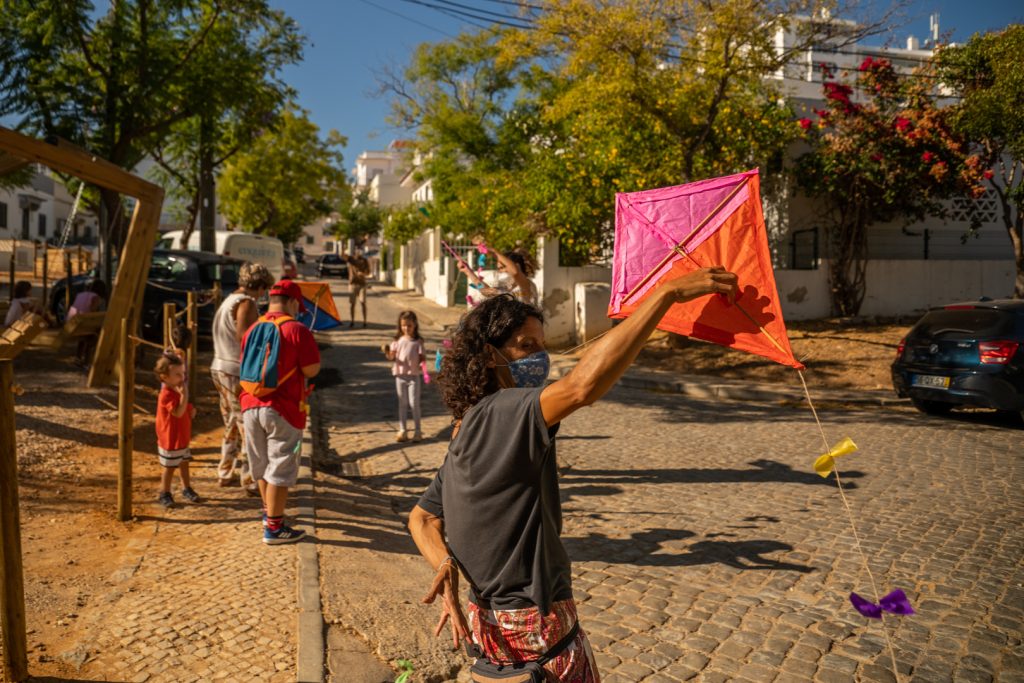
The next step was the creation of an Action and Reflection Network composed by residents and stakeholders of Rua Caldas Xavier. The first meeting of this network took place a month after the first door-to-door visits. After three online meetings, the group defined a landscaping project, the equipment to be installed, the type of vegetation to be used, as well as the action plan and program to be carried out for the first Living Street in Faro. Then, the Mayor of Faro and the Councillor for Urban Planning and Infrastructure gathered with 25 residents of the street, where they presented the requalification study for Rua Caldas Xavier and the main ideas of the project – the ones most voted by residents.
The Action and Reflection Network set up by the Municipality of Faro brought together around 50 members, including residents, local agents (organizations in the areas of culture and education, social, cultural, and religious associations, an artistic company and the security forces) and employees of the municipality. Around 25 residents, 15 members of local entities and 10 civil servants participated in the network that helped shape the project and decide which activities to implement in the Living Street.
“It was the first time and the first project in Faro where we had the active participation of all the people from the area to shape and choose the project they most identified with. We were very proud of getting to work with all the residents of Rua Caldas Xavier to bring to life a project they too were proud of.”
Sophie Matias, Councilor for Urban Planning and Infrastructure of the Municipality of Faro
Activities
The Faro Living Street program of activities consisted of a total of 20 activities/events in the most diverse areas of intervention – mobility, environment, culture and art, recreation, health, and well-being. Most activities were facilitated by the entities involved in the project, who moved their activities to the street and attracted new as well as old audience. Other activities saw the collaboration of residents who had some professional or personal knowledge and gave their time and skills. Most of these activities took place on Fridays in the late afternoon or on Saturdays.
- “Aromatize Your Life”: Workshop on gardening, organic farming, and sensory experiences with aromatic plants. Organized by the Municipality of Faro and local associations that treat people with mental illnesses and disabilities (ASMAL, APATRIS 21, AAPACDM), the activity involved residents of all ages, from children to the elderly. By planting plants, herbs and other vegetables of their choosing, participants developed a sense of belonging that lead them to continue taking care of the space as their own.
- “Inauguration of Faro Living Street – Mini Fado Concert with Alcino Bom”: The inauguration of the new Living Street was a celebration moment among all residents. The moment was accompanied by a traditional fado music concert of a singer from the Rua Caldas Xavier.
- “Construction of paper kites”: a recreational activity that brought together children and adults. Kids, parents, and grandparents got together in an afternoon workshop to rediscover an old children’s game, making use of memory, heritage, and fun to enjoy the street with different generations of residents.
- “Sings and Enchants – Mini acoustic concert performed by the duo DOUBLE T from ASMAL” and “Coral Singing Night with Grupo Coral Ossónoba”: two music activities promoted by two neighbourhood associations which are part of the project’s Action and Reflection Network. These musical concerts were moments in which the street came alive with sound and amazement of the many people who came together to watch the performances.
- “Teatro de Vizinhes” (Community Neighbours Theatre): a play that brought together a cast of around 20 neighbours to portray the Faro community and life, with comedy and good spirit. The play’s stage was the street, and it was one of the activities that gathered the largest number of people.
- Several other activities took place, such as an urban painting workshop, collective picnics, arts and crafts workshops and an open-air movie session.

What was the impact?
Measurements carried out before and after the implementation of the project confirmed that the closing of the street to external car traffic improved the air quality on the street, decreasing the concentration of nitrogen dioxide (NO2) and volatile organic compounds (VOC). The project allowed for a reconnection to nature and human-scale activities which improved the quality of life of its residents.
More than that, Faro’s Living Street gave residents of Rua Caldas Xavier a voice and an opportunity to reshape their street and neighbourhood. The result was a revitalized space, where the noise of cars was replaced by the sound of laughter, children playing and neighbours chatting. A greater interaction and mutual assistance among residents started happening, along with a greater collaboration between the Municipality and the various stakeholders involved in the project, whose work received more visibility due to the project. In addition, the teamwork necessary from the different departments of the Municipality inaugurated new and improved internal collaborations and communications.
Faro’s Living Street was so successful that it became permanent: residents of Rua Caldas Xavier will get to enjoy their new green space all year, while the Municipality reflects on its lessons to implement new Living Streets around the city.
Further information
Visit the website of the street
Contact:
Sophie Matias, Councilor for Urban Planning and Infrastructure of the Municipality of Faro
Óbidos, Portugal

A historic town, a literary festival, and the perfect opportunity to give back the streets to people!
The idea of Living Streets was brought to the attention of city planners by Portuguese regional authorities, who motivated Town officials to apply. The pilot area for the project in Óbidos is Rua da Porta da Vila, located at entrance of the historic centre, a place that welcomes about one and a half million visitors per year. For residents and local authorities, it was time to think about an alternative and sustainable project that could be tested and, if successful, implemented to improve experiences for both locals and visitors alike.
After a set of participatory meetings and actions to define a plan for Óbidos’ Living Streets, the project was inaugurated between the 14th and the 17th of October 2021, during the FOLIO Literary Festival, which is one of Óbidos’ biggest events. The newly pedestrianized street welcomed a fruit, flower and book market, a healthy street food area, aromatic workshops, nutritional screenings, children activities related to the environment and lots of music and animation. (See next sections for more info)
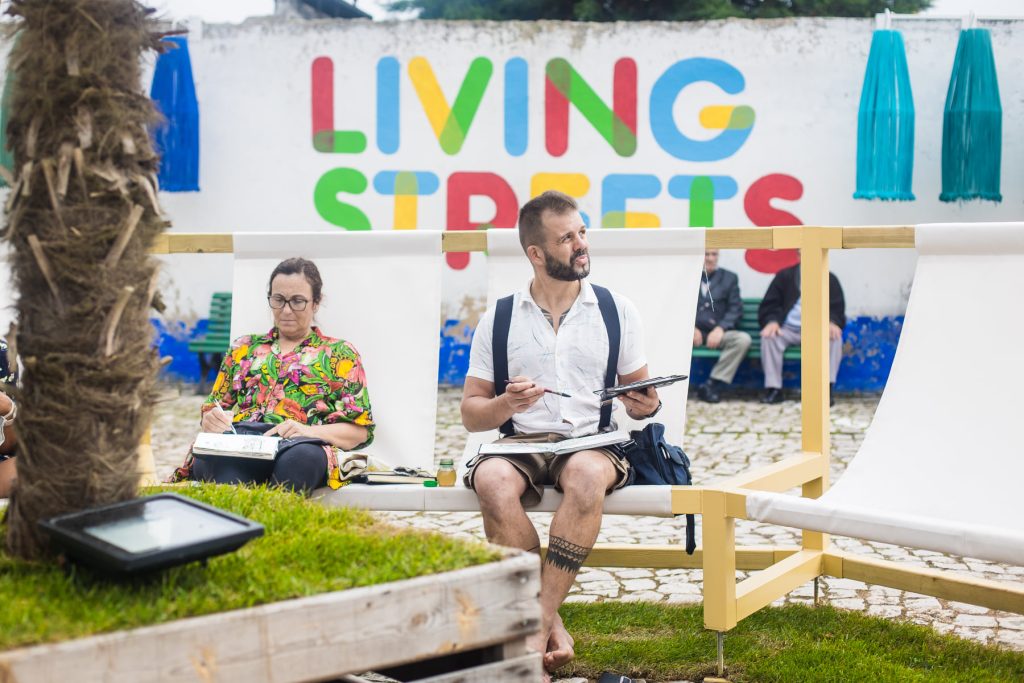
Flowers, fruits and books: what did Óbidos use to attract people to its Living Street?
Participation and citizen engagement are key for a successful Living Street. As such, Óbidos developed a set of actions aimed at building a network to help develop ideas. Residents, shopkeepers, public and private sector employees, and some close neighbors, who live or work on this street or in its immediate surroundings were gathered on a meeting to discuss the project’s implementation and design.
The first item in the agenda focused on the lack of green spaces. The group agreed that leisure spaces or pedestrian crossings should be created to enhance the natural landscape in the area. As a result, it was decided that the Rua da Porta da Vila would be home to an area with natural grass, various flowerbeds and structures with plants and trees. A leisure area, where people could meet, rest, read or play, was also planned, used sustainable materials only. Another request from those who visit the town was the organization of activities or leisure spaces for children. This request had been recurring throughout the years and there was an urgent need for a solution. After reflection, participants suggested the reuse of existing playground structures, as well as tree climbing activities.
To attract more people into a lively environment, while also promoting local businesses, a flower, fruit, and book market was developed. Óbidos is a UNESCO City of Literature, so it was understood that books should be included in the ordeal. On the other hand, the different fruits aimed to promote local farmers and producers. The presence of flowers aims to promote the various producers and florists in the Municipality of Óbidos, something that had not been a priority in Óbidos so far.
In parallel, an outdoor exhibition linked to the natural heritage of literature, by Pedro Basilio, as well as a sound installation in the Espaço O garden was included in the event. In addition to the creation of different areas, the entertainment aspect made up of different performances by the local community (brands, small groups, dance) complemented the program.
As one of the weaknesses pointed out by residents and visitors of Óbidos, the city was missing night entertainment, which would attract visitors who spend the night in historical Óbidos. As a result, concerts were organized at the end of the night at the Living Street to fill this gap.
In summary, Óbidos Living Streets contemplated:
- Green areas and leisure spaces
- Environmental awareness activities
- Healthy food
- Fruit, flower, and book market
- Community shows for street entertainment and shows at night
- Organization of outdoor exhibitions (ABC Urban Exhibition by Pedro Basilio and Exhibition Courtyard of Memories by Ossa Morena)
- Children’s play area (tree climbing structure)
- Healthy and vegetarian street food
The street was held during the Folio Festival, a significant literary festival which attracts visitors to Óbidos. The festival helped Living Streets, but Living Streets turned the neighborhood into a vibrant place, where people wanted to be.
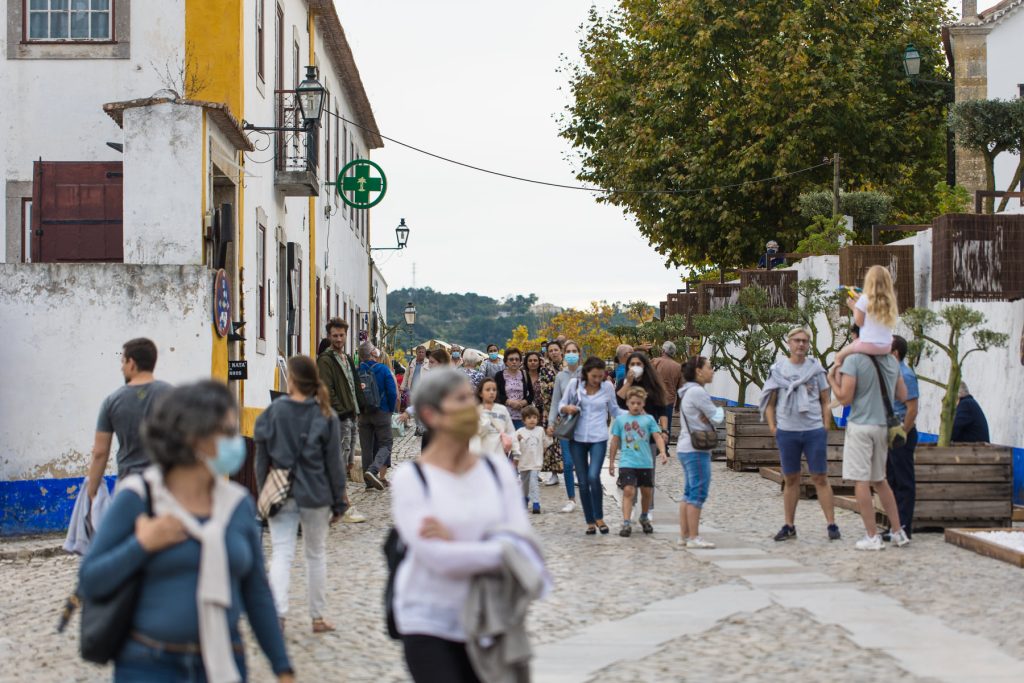
Lessons Learned
- Living Streets events are somewhat easy to organize, and they are a way to transform an ordinary neighborhood street into a vibrant place for people of all ages and backgrounds to celebrate, play and re-imagine a space
- The sky is the limit when it comes to ideas for Living Streets events. Choosing from doing something that has been done in a different city or organizing something completely new, there are many possibilities. It is a project open to new, creative forms of gibing back life to public spaces.
- Living Streets is a grassroots community effort. It is about local ideas promoted by local people to build relationships within the community, across neighborhoods and even across greater distances. As a result, community involvement reinforces relationships with local authorities.
- The project can help cities share their streets in new ways, more equitably, providing more access, for more people, to everything cities have to offer. With the participation of the local community and other local stakeholders, it is possible to achieve a better walking environment and inspire people to take more ownership of where they live and visit.
For Óbidos, one of the main lessons learned in terms of organizing such an event is that each stakeholder must be addressed individually and with different approaches, considering their specific issues: hierarchy, costumers, local citizens, and collaborators. Seeing the street as a laboratory for urban action, it’s often easier to convince decision makers to try a prototype instead of the full version of an idea. A prototype provides a way of seeing what we could learn.
Design thinking is also a useful methodology to overcome specific challenges, and after testing some of the prototypes discussed during the design thinking sessions, and subsequently being proven to be quite successful, some of the temporary measures became permanent. Many of the ideas implemented will be applied in other areas of the historic town, namely the area surrounding the castle (Cerca do Castelo) and where main events take place such as the Chocolate Festival, the Christmas Village, and the International Literary Festival (Folio). Areas that were used for parking will have new greener landscapes therefore improving visitor experience.
Further information
See the Óbidos Living Streets promotional video
Contact
Telmo Félix, Councillor for Urban Planning and Management, Energy, Urban Regeneration and Requalification, Sustainability and Administrative Modernisation.
Torres Vedras, Portugal

Transforming a forgotten street into a lively and multicultural place of light, color, and life!
The “Rua da Electricidade” is a street full of parked cars and vacant buildings in an industrial area next to Torres Vedras’ train station. The two main functioning buildings in the street are an upcoming health school and an Art studio, used by a group of approximately 60 international students for an intensive contemporary dance performance course. Living Streets was an opportunity to turn this street into a place of conviviality, inclusion, sustainability, and inspiration.
Created as a collaboration between two associations called ILÚ (Portugal) and Untamed (Belgium), the Performact dance course gathers students from many different backgrounds and nationalities in the Rua da Electricidade. This small art studio was the starting point for the whole Living Streets project in Torres Vedras, as they are the one who brought it to the City Council. The project was easily accepted, since it aimed at creating a meeting and leisure space for students and the community that promotes the values of tolerance, multiculturalism and sustainability; fostering the community’s awareness on the importance of physical and cultural activity; and promoting the urban regeneration of an abandoned industrial area.
With support from the Municipality, the street was closed to traffic and became the stage for a programme of events that included exhibitions, workshops, and art interventions on topics such as sustainability, environment, ecology, recycling, art, interculturality and social inclusion.
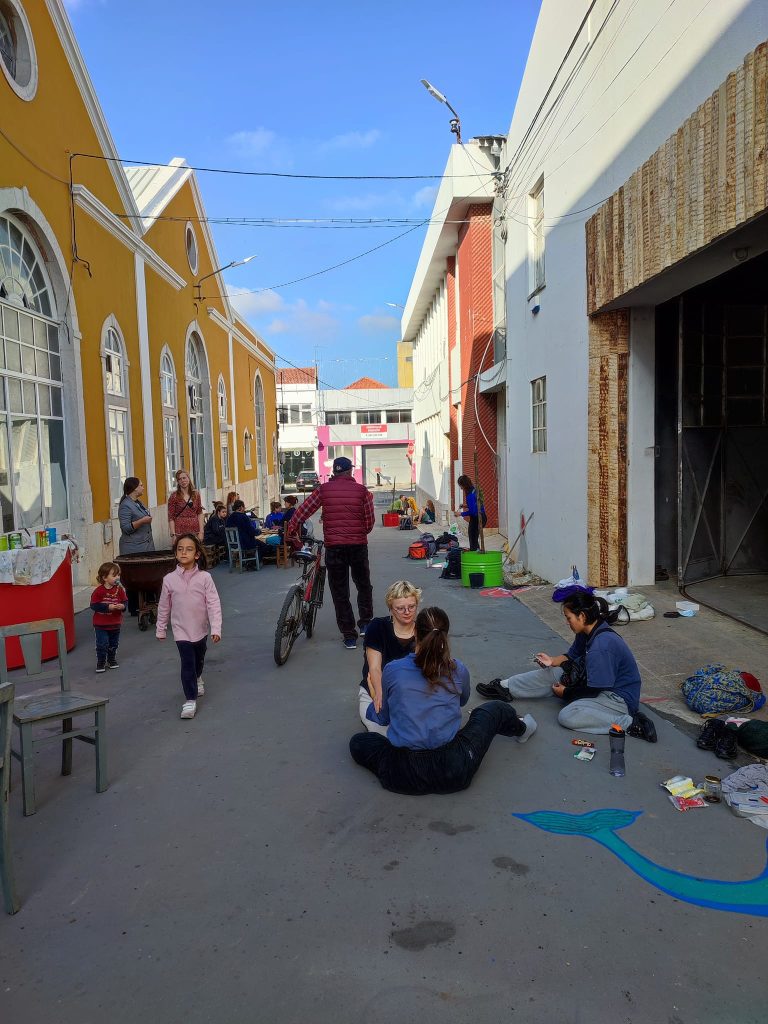
Co-creation and collaboration for a greater sense of community in the street
For the people of the Performact course and the Municipality of Torres Vedras, it was important that the street became a place of inclusion and culture, frequented and appropriated by the community as a whole. To achieve this, a strong culture of teamwork and co-creation was established, with dynamic actors involved. The directors and teachers of the Performact course, as well as City Hall technicians from the areas of culture, mobility, environment, etc., were invited to join the working group in charge of the works to be executed in the street and the design of the program. Local associations were invited to host their projects and activities in the Living Street, such as films screening for an international animation film competition. Students were encouraged to invite friends and national and social networks were used to promote the street to the public. This wide participation was key to develop a sense of belonging, so that the residents of Torres Vedras and the students of Performact could become long-term caretakers of the street.
Activities included:
- Animation film screenings in partnership with the local project Bang Awards. They made a selection of films that were in their international animation competition under the theme “Changes”. Films addressed subjects such as climate change, as well as cultural and social changes, etc.
- Use of the shared bike network called Agostinhas that was promoted during the whole Living Streets and offered to Performact students for free. A new bike sharing Station was installed near the ”Rua da Electricidade” boosting the emergence of new projects as well.
- The implementation of flower beds with native species and a vertical garden.
- Collective painting of murals with ecological paint and recycled materials.
- “Reading kites” and a multilingual open-air library to exchange books.
- The creation of an outdoor venue /podium for performances by students and guest artists from all over the world (see next paragraph for students’ origins). A wide range of performances and public workshops took place, such as: Contemporary Dance, Ballet, Aerial Dance, Yoga, Capoeira, Bollywood, Improvisation, Dramaturgy, language tandem sessions, but also photography exhibitions, animation films screening and dance shows’ videos screenings.
- The celebration of international days of the countries of origin of the students of the Performact course such as: America, Belgium, France, Germany, the Netherlands, India, Italy, Japan, Poland, Portugal, Spain or Russia, to spread sustainable habits, customs and traditions.
Living Streets was the occasion to promote social inclusion and to provide a place where the community of Torres Vedras could meet and interact, enhancing the essence of this culturally and socially rich area.

Impact of the project
The implementation of Living Streets in Rua da Electricidade also served as a push for the improvement of the general conditions of the street: the appearance and the structure of the street was enhanced thanks to a reinforcement of public lighting, repair works on the road itself and the sidewalks, the renovation of the buildings’ façade and the relocation of the garbage containers. All these changes made the Rua da Electricidade aesthetically better, more welcoming, while also encouraging soft mobility as it made the street more attractive to pedestrians and a bike station was installed, when it was previously mainly used as a spot for parking cars.
More than that, the project regenerated a dormant area into a place where people had a new-found sense of belonging and appreciation. The work performed in the Rua da Electricidade and the implementation of Living Street contributed to improve the perception of the street and the local projects, as well as a growing sense of safety and public space. A blooming centre for the whole community of Torres Vedras!
Further information
https://www.facebook.com/performact
Contact
Isabel Silva, Area of Culture (ACUL), City of Torres Vedras
Križevci, Croatia
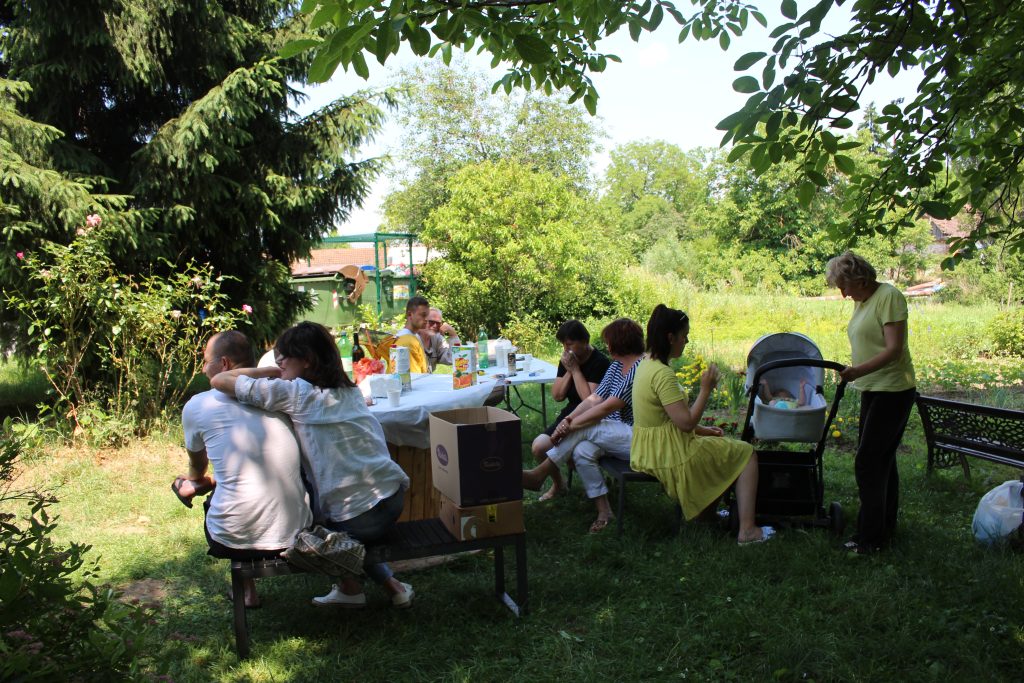
Created hand-in-hand by citizens, the municipality and the local energy cooperative, KLIK
For the Municipality, Living Streets was coordinated by the deputy Mayor, with a strong involvement of the heads of the following departments: finances, utilities, legal and general affairs and social services, as well as other employees. The local energy cooperative KLIK oversaw several actions in the districts. Key residents were identified in each neighbourhood for community activation, and the actions implemented were chosen amongst suggestions made by residents, who also provided help to set up the activities and actively participated! The Living Streets activities were carried out between June and August 2021 in five apartment blocks home to about 2,000 residents, who do not have their own yard.

Pushing apartment residents to reclaim outdoor spaces
2 weekends of activities were organized in each neighbourhood, one of which was an opening event where the residents, with barbecues and music from a solar DJ station, socialized, got to know each other, and agreed on working on the actions and sharing responsibilities. During the second weekend, residents made tables and benches, repaired and painted old benches, planted trees, blueberry bushes and flowers, collected waste and painted a mural. Various games and piñatas were prepared for the children. Each neighbourhood had its own “chef” in charge of grilling and keeping a good atmosphere. As closing event for Living Street, activities were held on the main square of Križevci, for the festival of sustainability “KLIKni na održivo”. During the closing events, all residents had the opportunity to ‘live’ what was done during summer within the five selected neighbourhoods, take part in DIY workshops, learn about sustainable mobility and healthy living, but also be inspired to change their own neighbourhood.
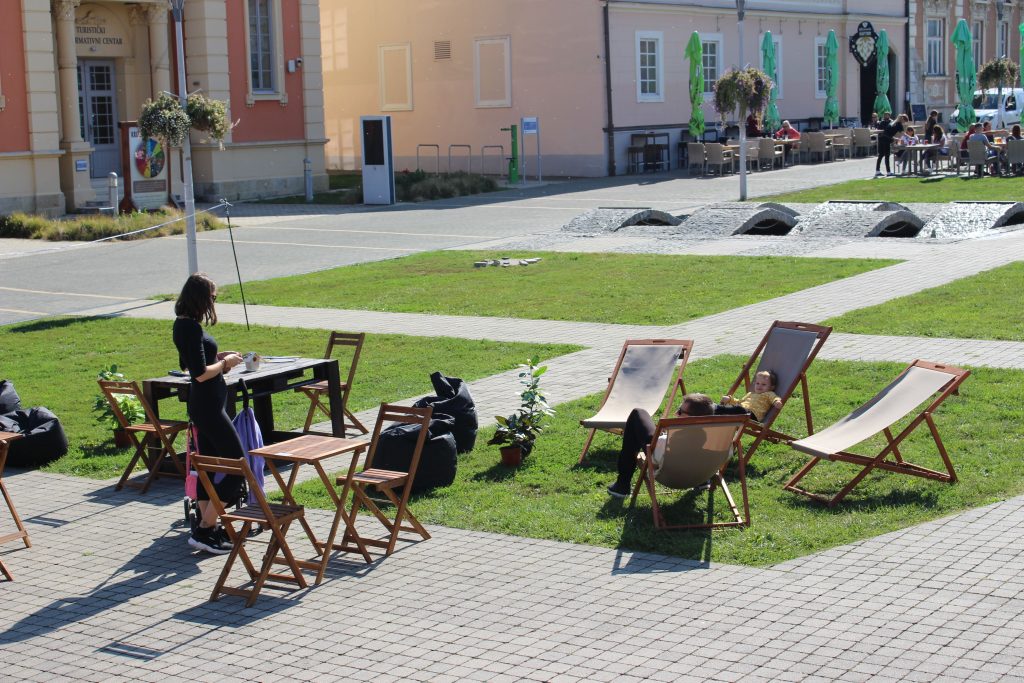
Impact of the project
The first opening event in “Dom Zdravlja” neighbourhood exceeded expectations as the residents themselves were thrilled with the concept of Living Streets and had a lot of ideas and suggestions of activities on how to make their neighbourhood even better and suitable for socializing. Everyone was involved in the planning of working actions, from the youngest to the oldest. They made plans together. The success of Living Streets was demonstrated by the fact that the residents continued to socialize in the neighbourhood almost every night throughout the summer. A similar feeling resulted from the activities in 2 other neighbourhoods, notably in the “Autobusni” neighbourhood.
The final event on the main square of the town was a prelude to other activities that will be done next year outside the five neighbourhoods and with a higher number of citizens, especially from the rural area.
The residents which took part in the Living Streets expressed their interest in continuing such activities, and reportedly reduced the use of personal cars for their commute and decide to cycle and walk more instead: they became more aware of the impact of cars on the environment and their own health, but also on safety and noise. Elderly people from the 5 neighbourhoods reportedly spend more time outside since the installation of benches. Living Streets should continue in Križevci in a more rural area in cooperation with local citizen boards, to create a greater impact outside of the urban zone. This first edition in the summer 2021 highlighted the importance of putting more effort in educating and raising residents’ awareness on their participation in such activities, especially the elderly population and also on alternative mobility.
Further information
Contact
Ivana Šatrak, Expert Associate at Križevci Climate Innovation Laboratory (KLIK)
Labin, Croatia

A living lab for climate change adaptation measures
Several workshops took place during the weekend of 25th and 26th June 2021 to raise citizens awareness on the harm of single-use plastic, but also on renewable energy sources and protection of water resources, waste sorting, short production & consumption chains, and active mobility (cycling and walking). It was also a way for the municipality to prepare the ground to turn permanently some of the streets into pedestrian zones.
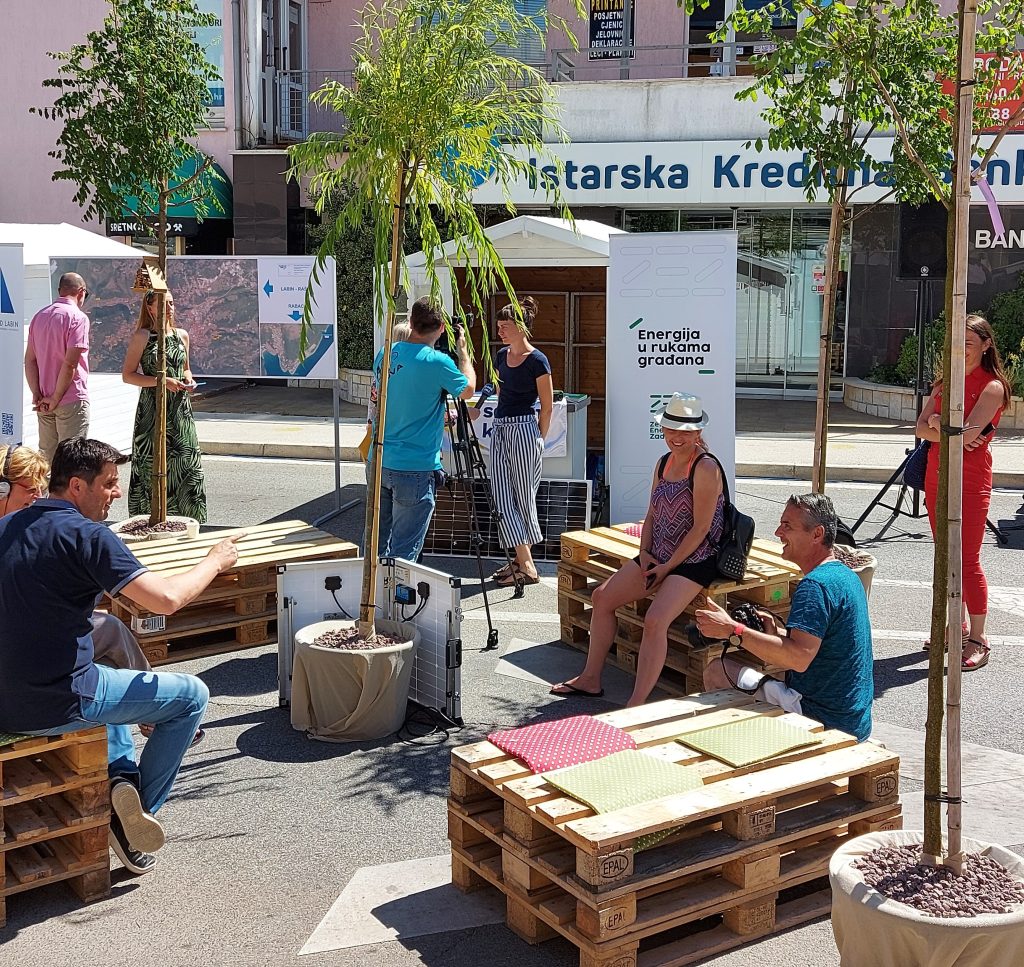
A joined initiative bringing together the city, NGOs, companies, and citizens
The City of Labin initiated the Living Street with the municipal communal and water supply company. Other NGOs and companies joined the city to coordinate the actions: LAG Eastern Istria, Alfa Albona Association, Rabac Cycling Center, Terra Hub and Green Energy Cooperative. The coordinators gathered several local civil society organisations, among others: the zero-waste local group, local artists, and the cycling centre. The city engaged the Croatian Environment and Energy Efficiency Fund for the event to hand-in a new truck for separated waste collection. Citizens and residents participated in the design of the Living Street through a workshop to answer the question “what does the street of your dreams look like?”, using the tools “Radar of the Future” and “Emotional maps”. Bringing together all these local actors and citizens led to the event being a success.
Impact of the project
Thanks to this weekend full of educational activities and planning workshops, citizens understood the necessity of reducing car traffic in specific areas. For the city it was the opportunity to have citizens join the urban planning process in selecting the future pedestrian zone, to obtain feedback on different options and schedules. It was also the starting point for Labin to become plastic-free and a lighthouse for the whole region of Istria for its Green Plus plan. Connected to the creation of a pedestrian zone in the city centre, the municipality is finding synergies with other measures to revitalize the old historic city centre, not only in terms of energy efficiency, but also culture, business, life and tourism, and IT to create a “smart city”. The reflection on mobility will be connected to the creation of a network of cycle paths. Living Streets enabled the city of Labin to complete its strategic development in a simple and fun way, provided its citizens with information on opportunities and directly involved them in the hope of launching new initiatives that will contribute to the city’s objectives.
Further information
http://www.labin.hr/living-streets
https://m.facebook.com/RadioLabin/videos/living-streets-labin/840812659863180/
Contact
Robert Mohorović, City of Labin
Poreč-Parenzo, Croatia
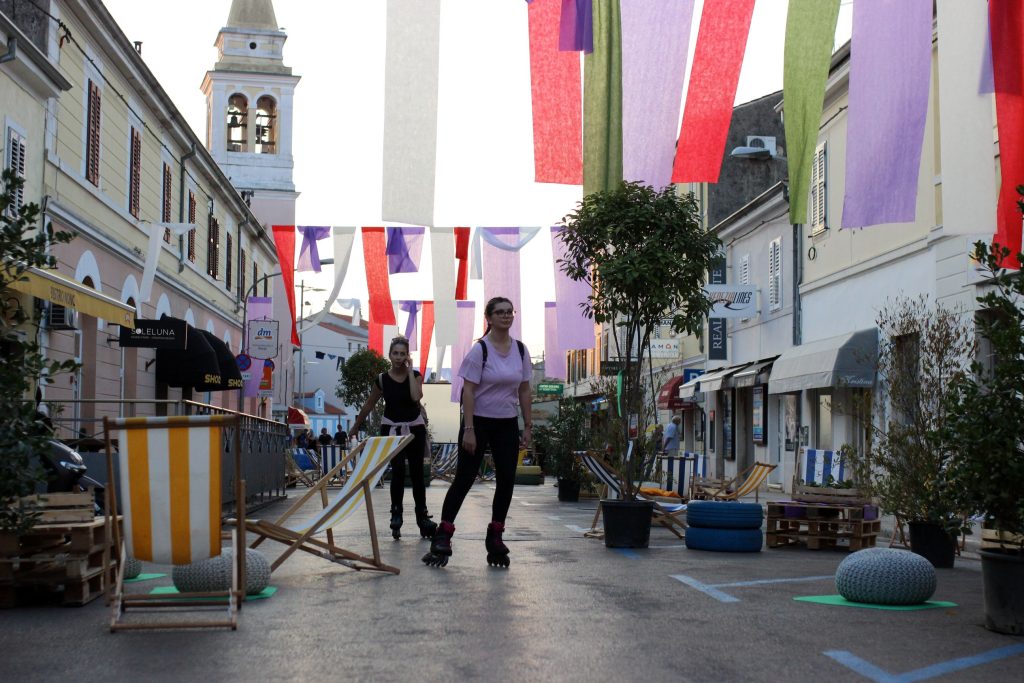
Living Street: A space for everybody
Zagrebačka Street was closed for cars and opened for people, plants, and animals. A two-day event was planned but almost did not happen due to the unpredictable weather in September. To set up the scene for the Living Street, the Association Zona was helped by many locals, private companies, and public institutions. None of the used props and furniture were bought, everything was borrowed, and some objects were rented. This joint effort contributed to spread the word about what was going to happen and created the first good alliances.
Zagrebačka street is a busy street leading from Joakim Rakovac square to the main square – Liberty Square, the last point of contact of cars with the pedestrian city centre. Many of the locals (if not the most) would like to see this street permanently closed to car traffic, at least during Summer, when their small city of 17.000 inhabitants takes up to 100.000 tourists a day. Cars are not the only problem: the mass of people somehow becomes a moving infrastructure too.
The event on September 24th and 25th 2021 was titled “Zatvaramo Zagrebačku” (“We are closing Zagrebačka street” in Croatian), with the motto “no cars, just people, plants and animals”. The program included the temporary closure of the street to transform it into a big chill-out green and quiet area. Activities included free lectures, workshops, an open jam session, film screening and urban talks. 500 plants were distributed to citizens (rosemary, lavender, and strawberry plants). Additionally, Nikola Tesla Street, a continuation of Zagrebačka Street, was turned into a Slow Speed Zone for the two days.
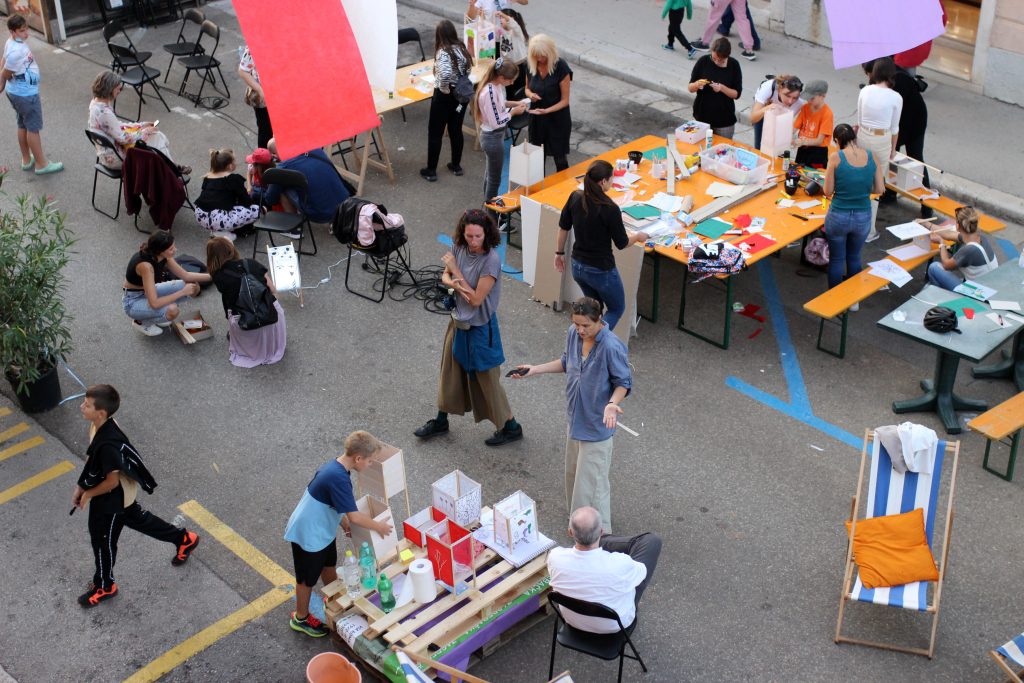
The parklet – pivotal tool in urban design
The definition of PARKLET states: ”PARKLET fulfills an important function: in addition to encouraging socialization, it also represents a public space accessible to all.” By introducing the PARKLET concept on the streets of Poreč–Parenzo, the project aimed, in cooperation with citizens, to systematically introduce long-term micro-transformations of city streets and spaces that are often congested with traffic and cars, especially during the Summer months, to point out the importance of public space in urban areas and encourage lower rate of personal vehicle use, as well as other sustainable mobility means, and create urban spaces that will no longer serve to cars but to citizens.
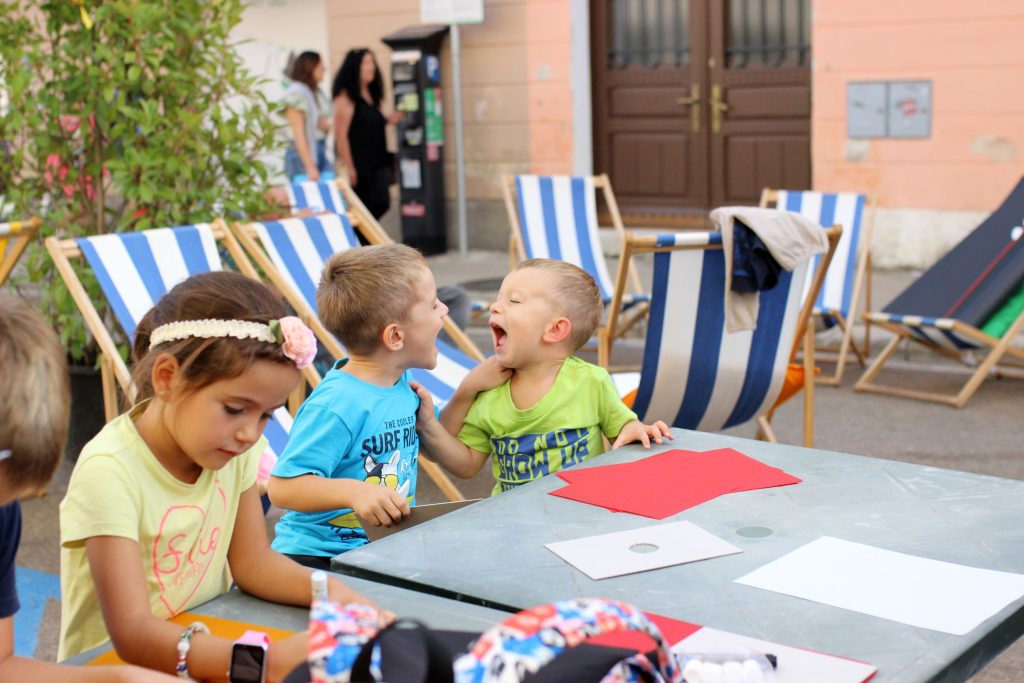
Impact of the project
Noise pollution during Summer is usually very high in Poreč. Also, people are living in times of content oversaturation. This is the reason why Association Zona wanted to create a quiet space where people will feel safe to slow down and rest their senses. When there were no programmed activities, the street was a big quiet living room. It was also important to make space for everybody – regardless of their economic status. This is the reason why there were no commercial activities of any kind. Streets are providing space for community recovery and during pandemics the importance of public space as provider of safe interaction and beauty was emphasized. Living Streets opened spaces for many people to talk and feel better.
It is estimated that about 1,000 people (citizens, residents) have been involved in the process through answering the survey (266), the preparation of events (100), the Q&A event (20), participation to the workshops (100), and the final event (500). Nothing could happen without the buy-in from the local community.
By implementing the Poreč Living Streets project, and especially within the final ‘’We’re closing Zagrebačka street’’ event, the city closed one of its most important streets to motorised traffic. The Town of Poreč-Parenzo seized the opportunity to turn it into a social hub and used the space to bring citizens together and engage them on energy and climate issues. By introducing one of the potential urban public space transformation measures, citizens were given an opportunity to participate, state their opinion about climate and traffic issues, while experiencing the potential of a car-free city at the same time. In turn, Town of Poreč-Parenzo has experienced the positive impact of citizen participation.
New potential locations for future city parklets are being considered and there is hope that the concept of Living Streets will continue to transform the streets of Poreč-Parenzo into more citizen-friendly and green areas in the future.
Further information
http://www.porec.hr/prva.aspx?stranica=95749&j=CRO
Contact
Gordana Lalić, Director of Parentium d.o.o., Poreč-Parenzo’s municipal company for energy efficiency and climate change projects
